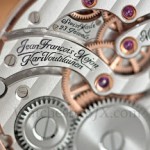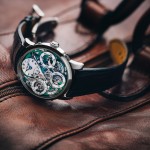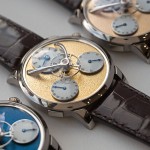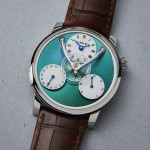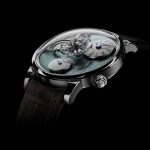In-Depth: MB&F LM Sequential EVO
Twin chronographs with a twist (and a few caveats).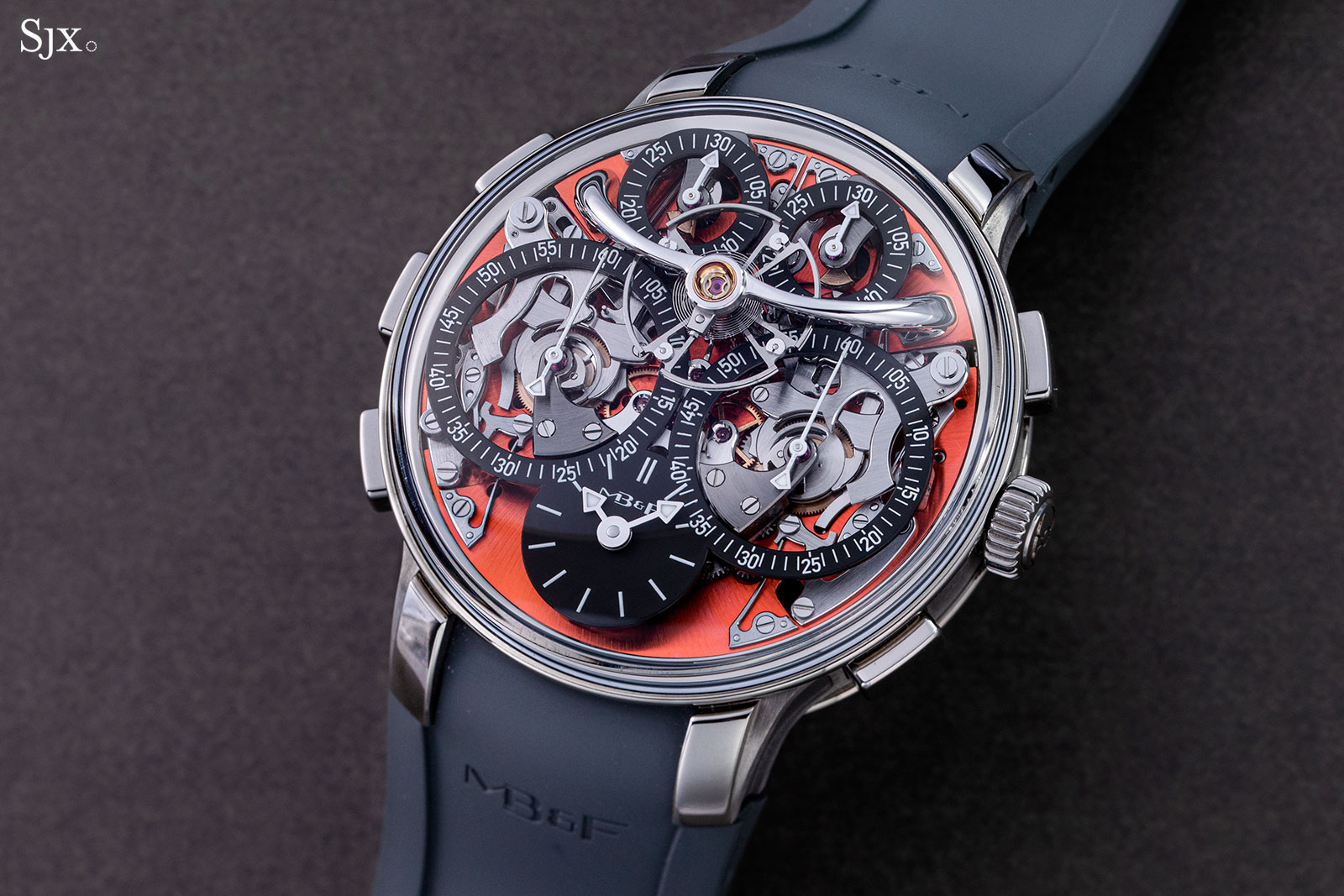
MB&F has just rolled out its very first chronograph, which becomes the second model in its EVO line of sports watches that began with the LM Perpetual EVO, now the brand’s bestselling watch. Christened the Legacy Machine Sequential EVO, the new chronograph continues with the same aesthetic of an open dial that reveals the mechanics along with a streamlined case.
The LM Sequential EVO is most interesting for its movement, which is paradoxically complicated yet simple. Developed by Stephen McDonnell, a constructor who’s been a longtime collaborator with MB&F, the movement is a double chronograph capable of recording twin times simultaneously along with a “Twinverter” mechanism that can either operate both chronographs or invert them – a complicated endeavour. But the setup is a simple one, essentially two discrete chronograph mechanisms that operate independently but linked by the inverter mechanism.
Initial thoughts
I was impressed by the LM Sequential EVO when I first saw the watch. It is a big, imposing watch with sleek lines and a wide face that is filled to the edges with intricate mechanics and quadruple sub-dials packed tightly together. Despite its size, the watch wears well due to the shape and length of the lugs, while looking like a grand complication on the wrist.
And once I understood that it was a double chronograph, I was even more impressed; it looks even more complicated than the top contenders in the category, namely the Lange Triple Split and Audemars Piguet Royal Oak Concept Laptimer.
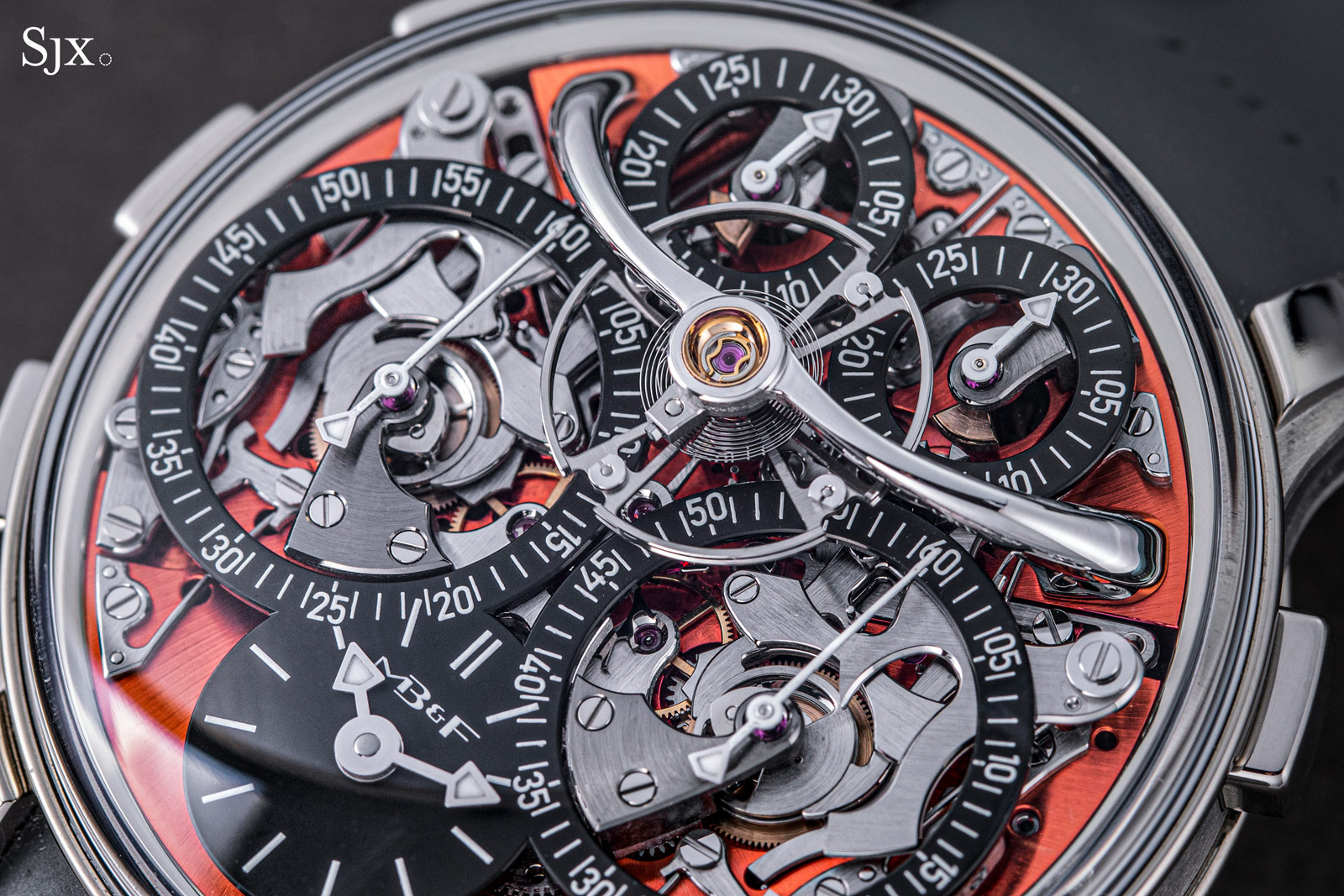
Grand comp-level good looks
But after understanding the movement, it is apparent that the watch looks more complicated than it actually is. The movement is certainly complicated in the sense that it’s made up of a lot of parts – almost 600 to be exact – but the approach is straightforward: the movement is at its core composed of a pair of identical, independent chronograph mechanisms, albeit executed in a thoughtfully optimised and compact manner. The degree of optimisation and thought in its details is impressive, a fact brought home when Mr McDonnell himself explained the movement.
The double chronograph is actually twin stopwatch mechanisms that are entirely independent and conventional – an approach that calls to mind the twin time zone watches of the 1970s that relied on two tiny and separate movements. In between the two chronograph sits the Twinverter, a secondary mechanism that toggles the on-off state of each chronograph’s column wheel. The Twinverter is arguably the most novel aspect of the movement, though it is easily understood, having been built according to familiar mechanical principles.
At the same time, the movement has a notable omission: a flyback function. It appears that a flyback can be incorporated with some modifications, but perhaps that extra is being saved for subsequent editions.
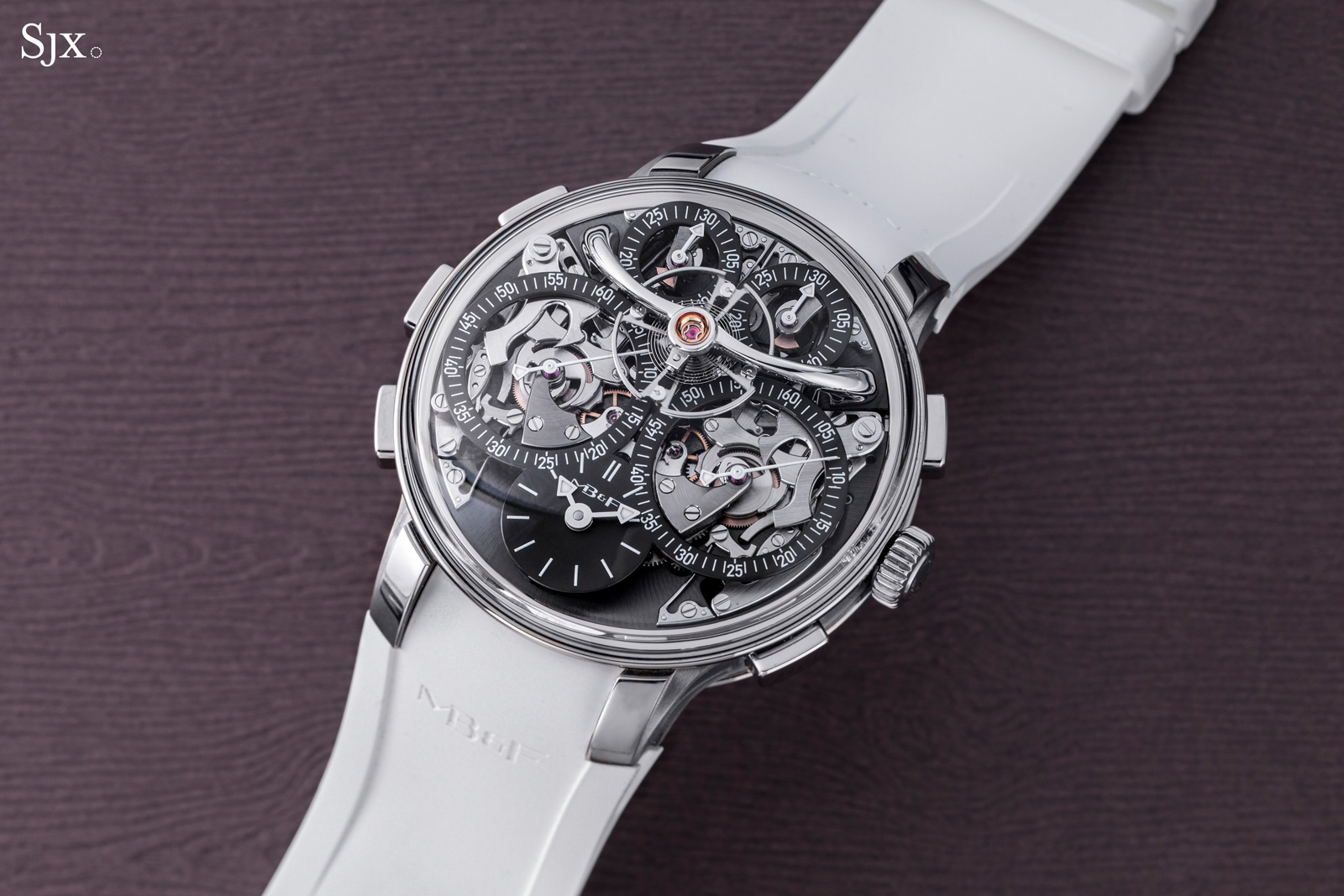
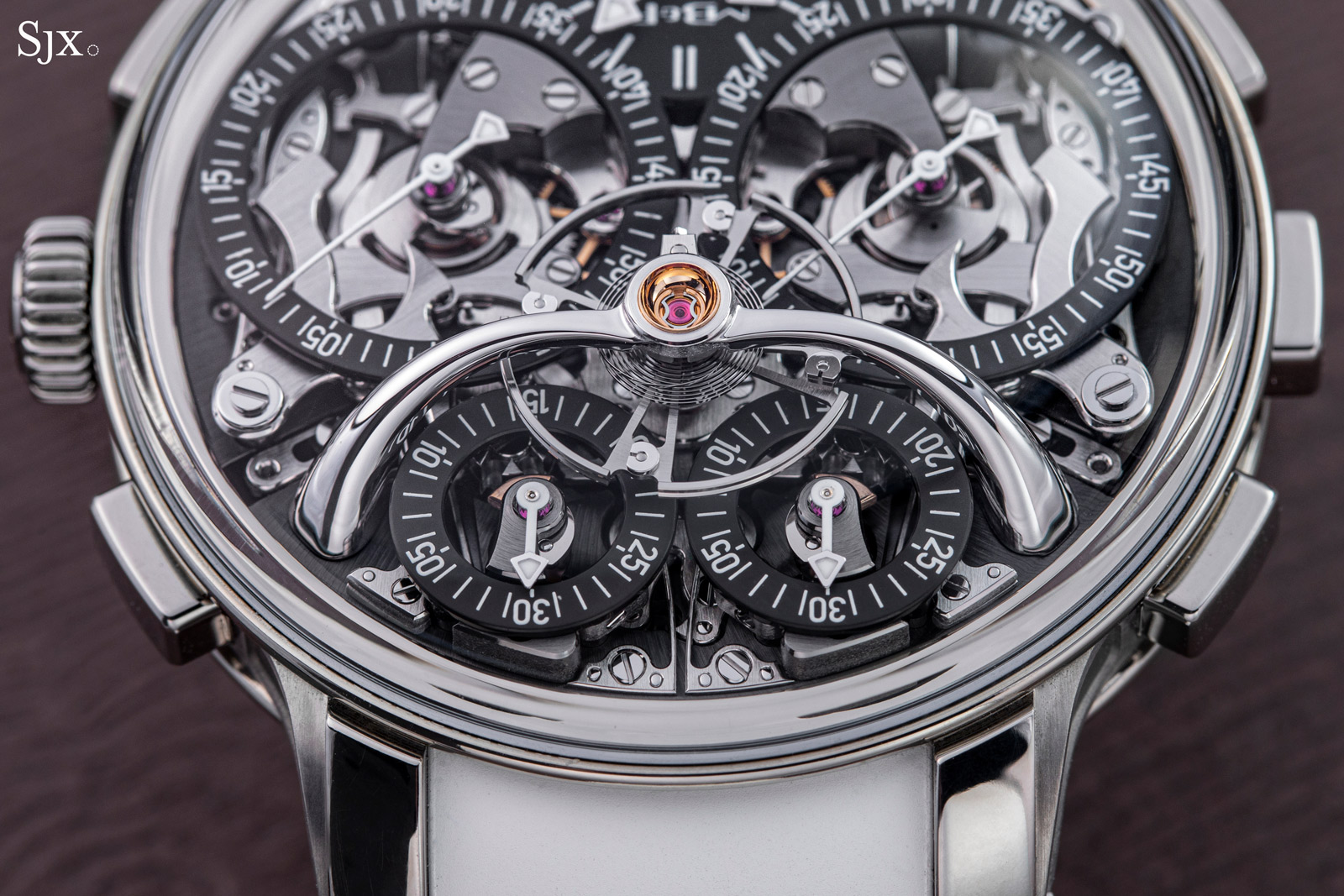
Besides the clever-but-simple Twinverter, the movement is at heart two identical but mirrored chronograph mechanisms mounted on the dial side of a base movement. If anything, it is a clever construction that optimally utilises the narrow space between the base movement and domed crystal.
In fact, the slimness of the chronograph works are more noteworthy than the construction of the chronographs themselves. It can be observed that the chronograph levers are unusually wide and flat, a profile that allows them to fit within the narrow vertical space under the crystal that is nonetheless laterally expansive due to the diameter of the movement.
The criticism of the LM Sequential EVO stems in part from the ingenuity of its predecessor, the LM Perpetual, which at its core was a truly novel mechanism for a perpetual calendar – a central axis driving a plethora of wheels – that was unlike any other that came before. Though entirely different in terms of function, the LM Perpetual is more innovative in terms of mechanics compared to the Sequential EVO.
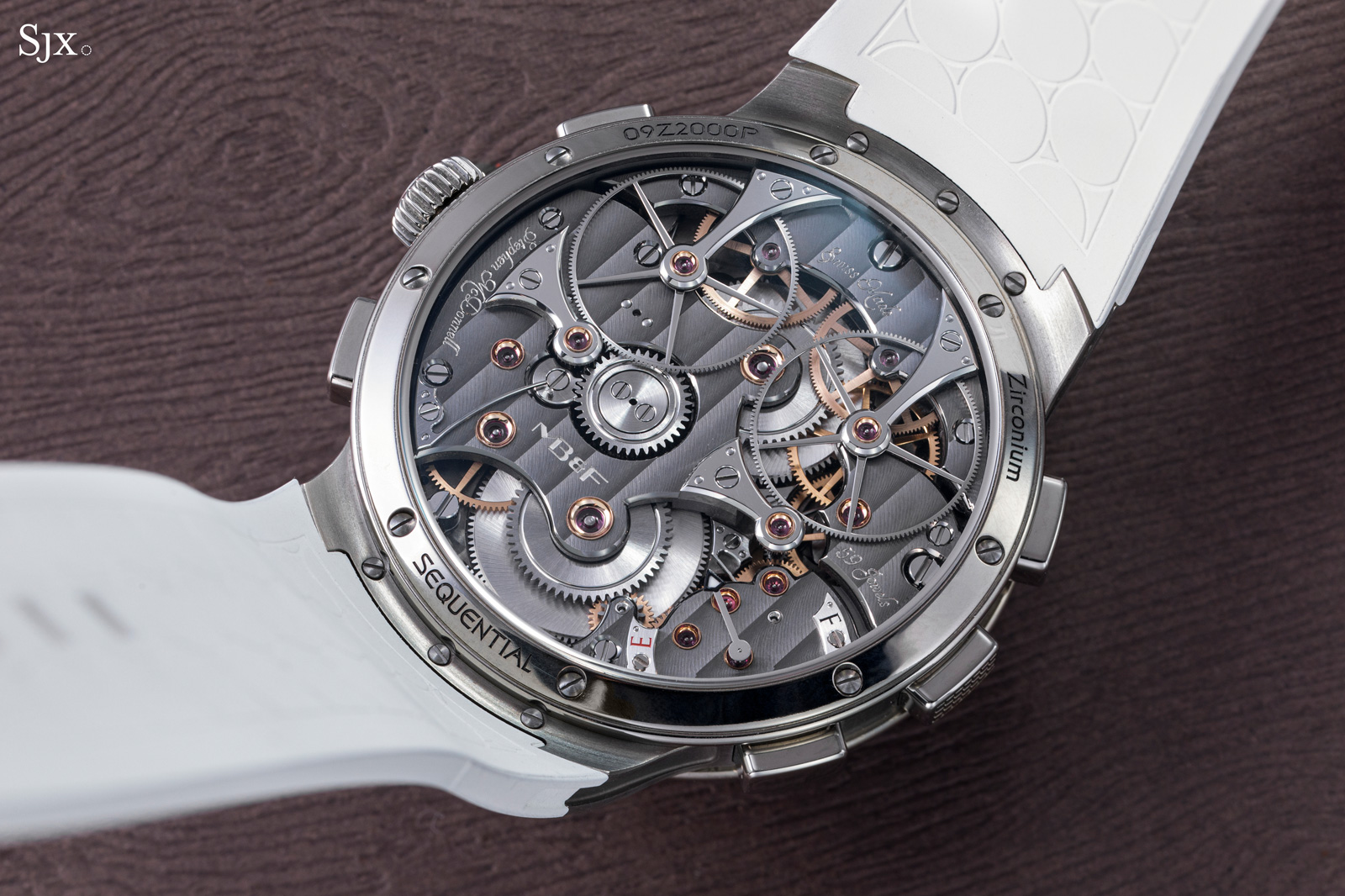
That said, the Sequential EVO is still a chronograph unlike any other in terms of versatile functionality and aesthetics. And aesthetics are important because they position this closer to Richard Mille than Lange, which will have implications for its value proposition as we discuss below.
As for the versatility in functions – achieving the same via alternate mechanical means will result in a prohibitively complex movement. An example of a chronograph that similarly thinks out of the box is the AP Laptimer. There is some overlap between the functionality of the two, but the Laptimer is fundamentally different, and arguably more complex. It can measure two alternating elapsed times, but does so with an intricate setup of twin, alternating rattrapante mechanisms along with a modified reset system logic. The fact that AP debuted the watch with much fanfare but never developed the mechanical concept further indicates the uneconomical complexity.
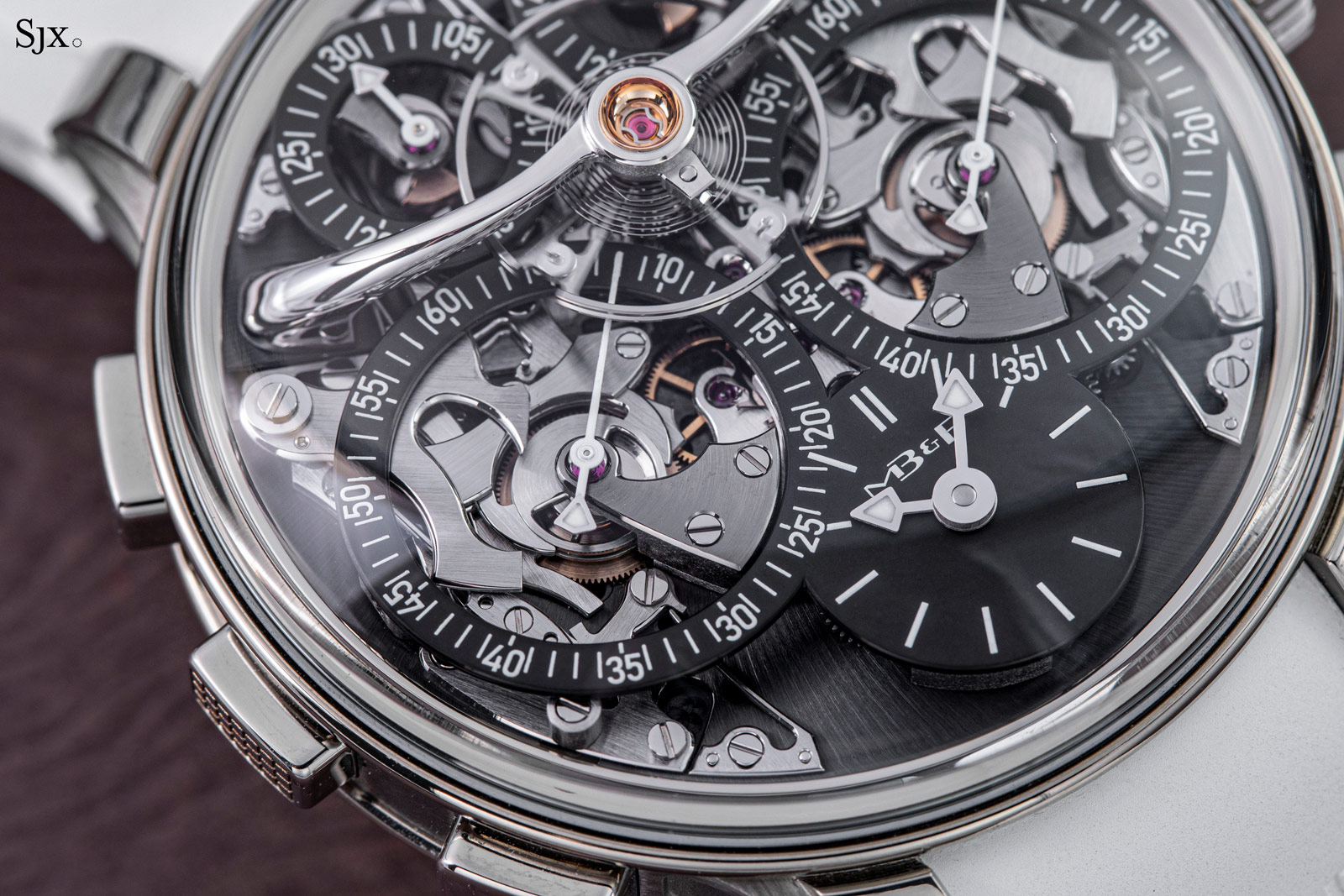
The last point to make is the price, which is US$180,000. That makes it about 10% more expensive than the Lange Triple Split, a more traditionally constructed movement but certainly one that is more complicated (and arguably better finished). And the Audemars Piguet Laptimer, which is more complex than both the Triple Split and Sequential EVO, cost about US$225,000, albeit in 2015 when it was launched. By the measure, the LM Sequential EVO is steeply priced.
However, set against watches in the same segment when it comes to hyper-mechanical aesthetics, the LM Sequential EVO is a value proposition. The Richard Mille RM 65-01 split-seconds chronograph is twice as expensive, while the RM 72-01 is merely a standard chronograph with date and costs the same as the Sequential Evo.
Evolving the legacy
MB&F’s Legacy Machine (LM) line was originally unveiled in 2011, conceived to be avant-garde timepieces designed during the era of Jules Verne in the words of founder Maximilian Büsser, explaining the steampunk aesthetics and traditional elements in the movement.
Starting with the LM1, the line has since developed into a range of models, but all characterised by a domed sapphire crystal revealing a large balance wheel on the dial, along with various complications indicated across several sub-dials, as well as a base movement with classically-styled movement bridges. Despite all that, the LM is still a product of MB&F, so the sum of the parts are decidedly contemporary, despite the elements of classical watchmaking visible on the back.
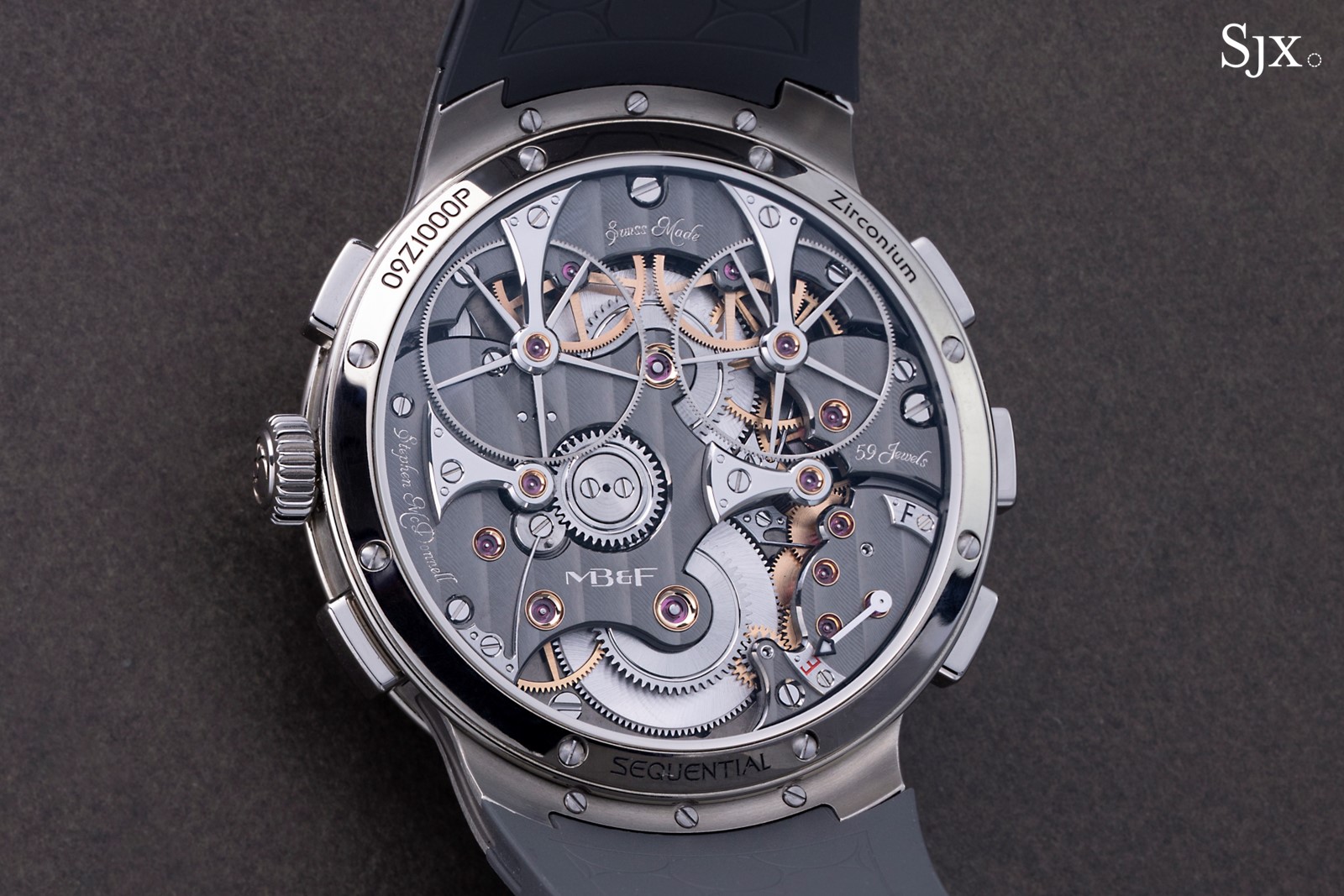
Very much in the LM style, the movement of the Sequential EVO with its traditional elements matched with an unconventional construction
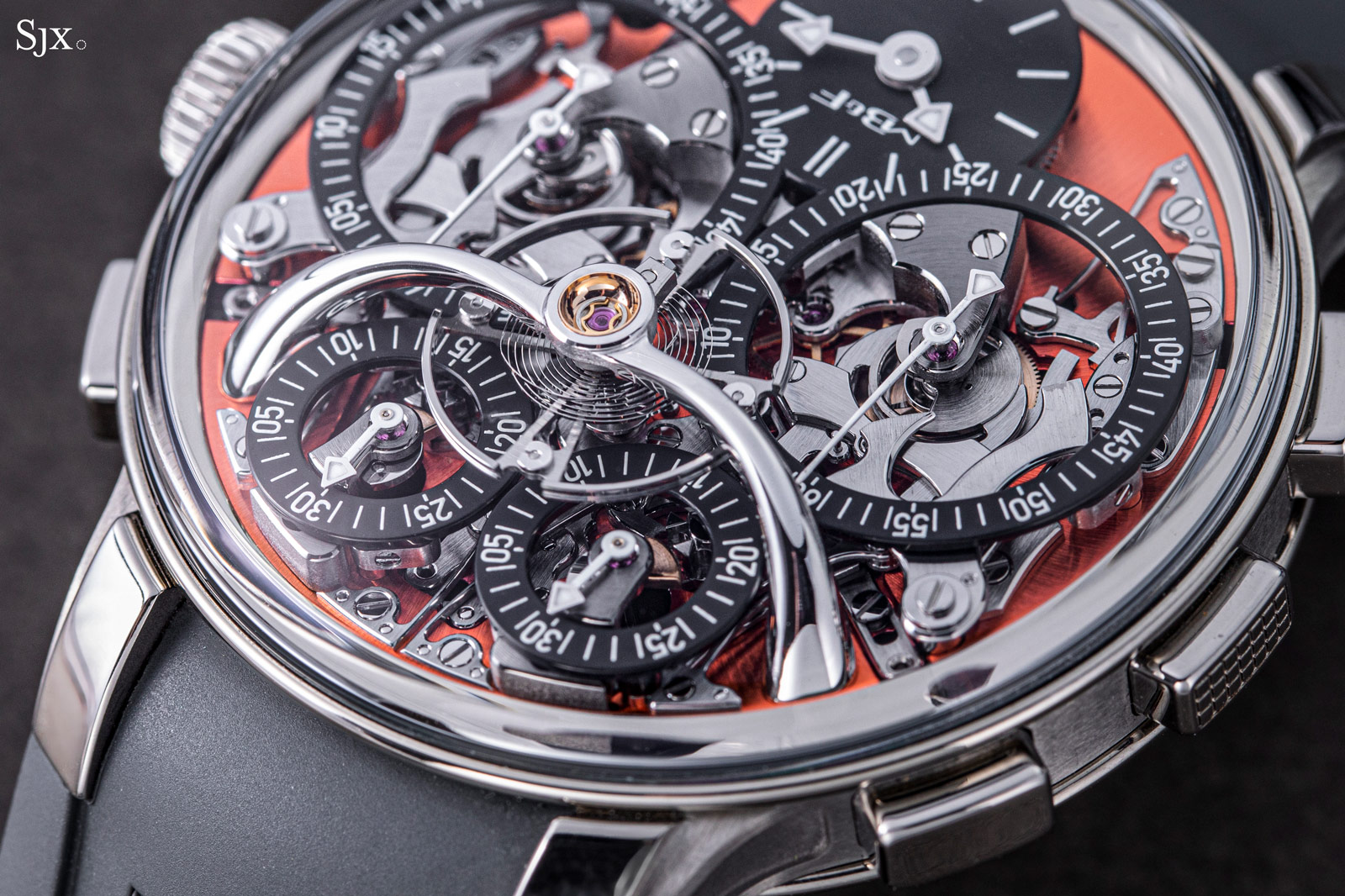
And on the front, the extra-large bridge for an extra-large balance wheel, another signature feature of the LM
The Sequential EVO continues all of that, but the contemporary aspect of the design has been dialled up, hence the “EVO” moniker. This was first done with the LM Perpetual EVO of 2020, which was essentially a sporty version of the original LM Perpetual.
The EVO facelift for the perpetual calendar was both aesthetic and functional. The dial and movement remained unchanged but were installed in an all-new case with a streamlined form and 80 m of water-resistance, setting it apart as a sports watch (though it is probably best not to use the pushers while underwater). And an integrated rubber strap left not doubt that the EVO is indeed MB&F’s take on the integrated-bracelet sports watch.
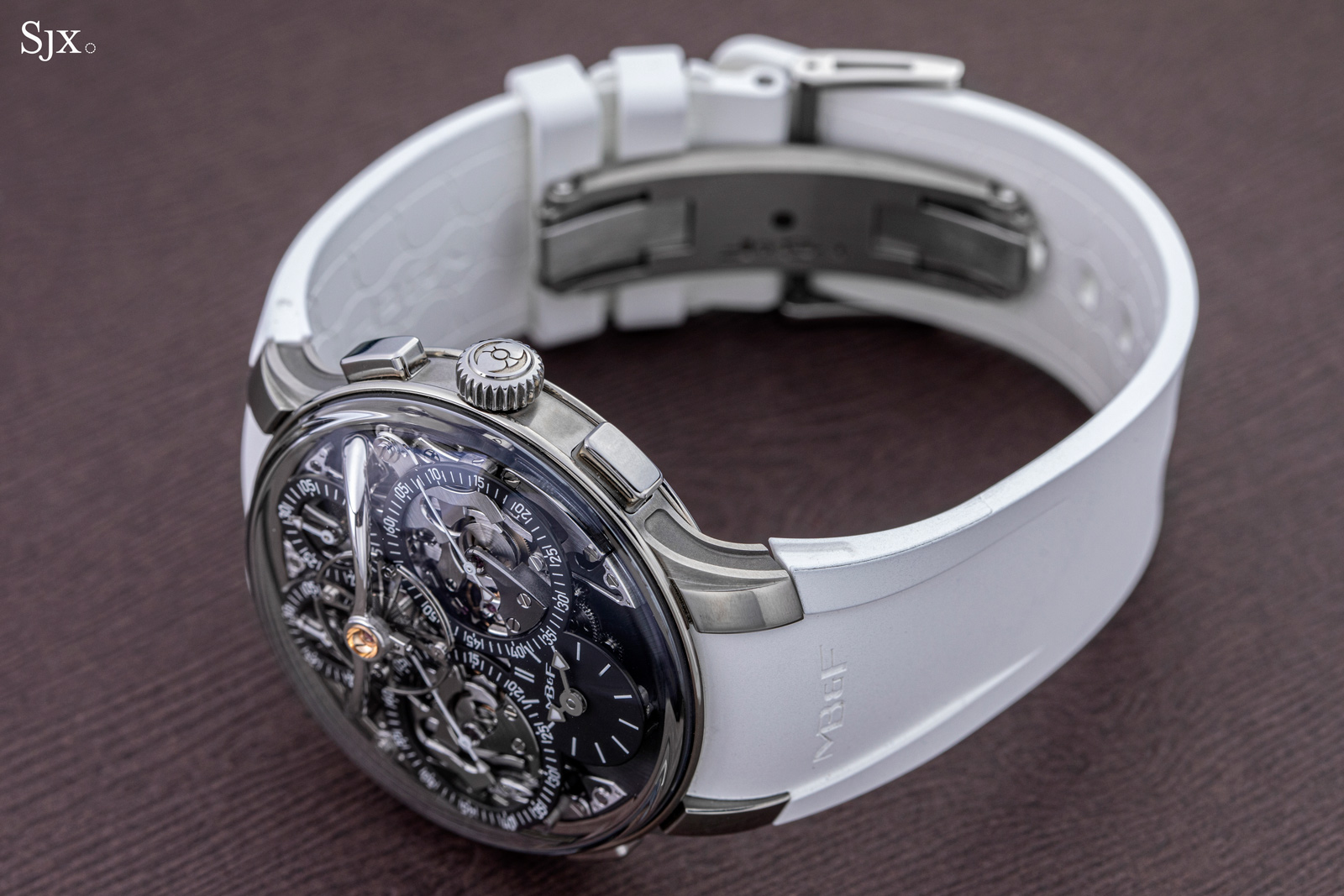
The integrated rubber strap attaches to the case via three screws between each pair of lugs, limiting strap options but ensuring for a streamlined fit
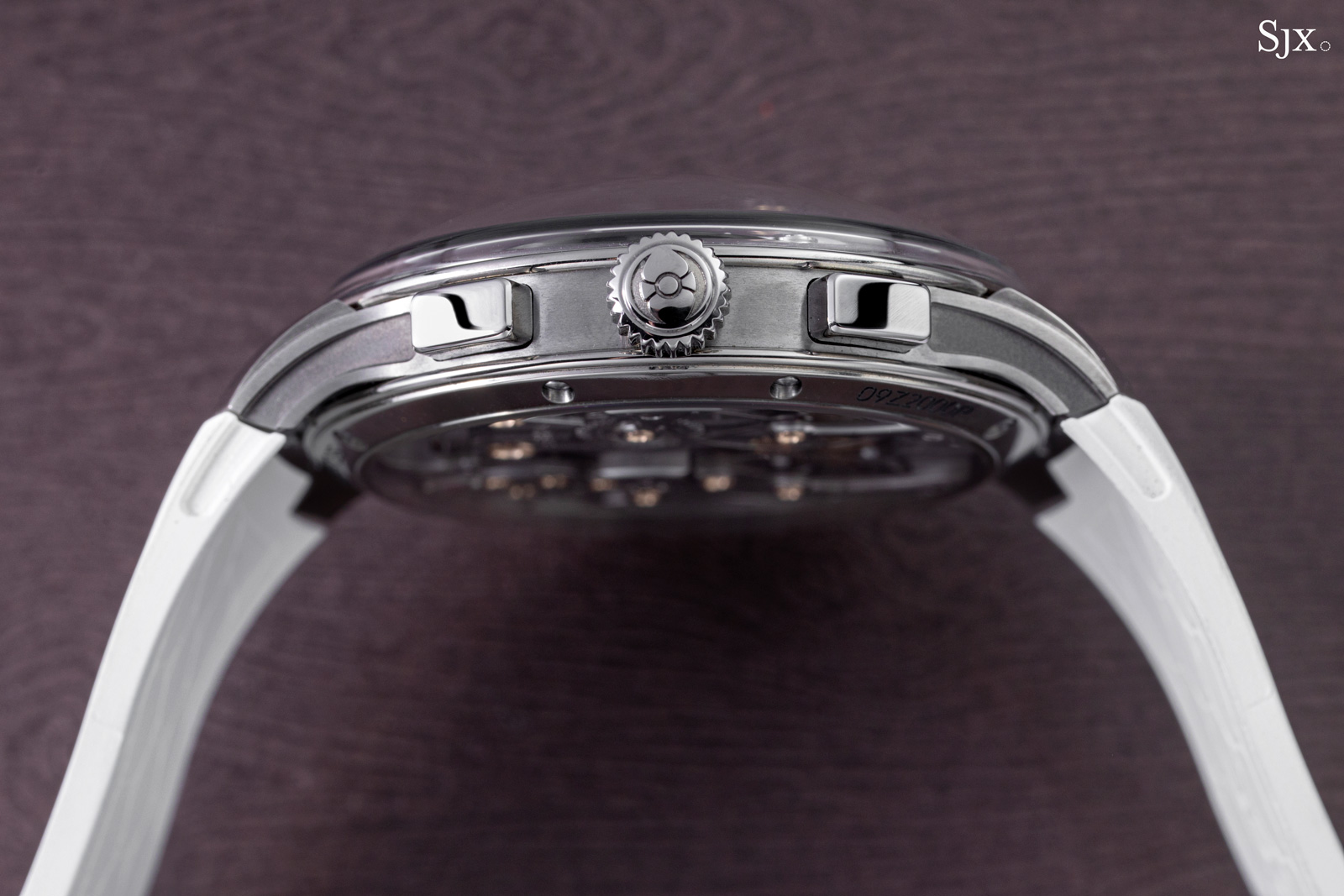
The integrated rubber straps flows into the case
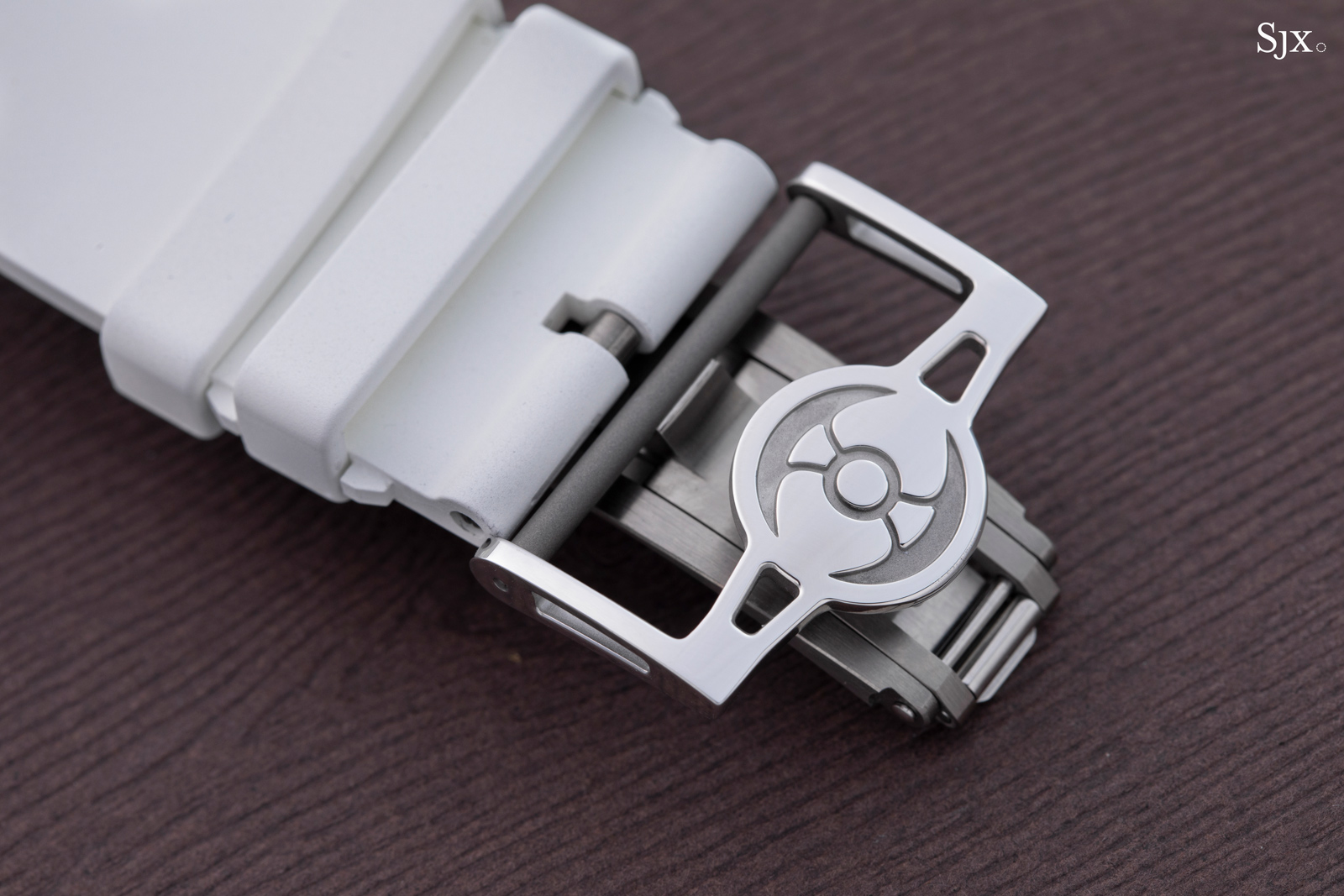
And the buckle is the sprung, double-fold clasp MB&F uses for all its watches and is supplied by Chanel
The EVO Perpetual was also unusual for having its case in zirconium – an uncommon metal in watchmaking due to the difficulty of machining the alloy. However, zirconium is hypoallergenic, lighter than stainless steel, and more rigid than titanium, making it a good choice for a sports watch. Zirconium is softer than titanium, however, so will be more prone to scratches, although its hardness will depend on the exact alloy composition.
The Sequential EVO continues with the zirconium case, making the material something of a trademark for the EVO line, as well as the innovative case construction first found on the perpetual calendar.
The EVO case boasts improved shock resistance thanks to an annular damper that functions as the movement ring. Ordinarily a simple metal ring to fill up the space in the case, the steel movement ring of the EVO has been constructed as a spring-like structure that is flexible enough to absorb shocks in the lateral and vertical directions. This is noteworthy for being done in a traditional material instead of the polymers and carbon composites that are often the norm when it comes to modern shock protection devices.
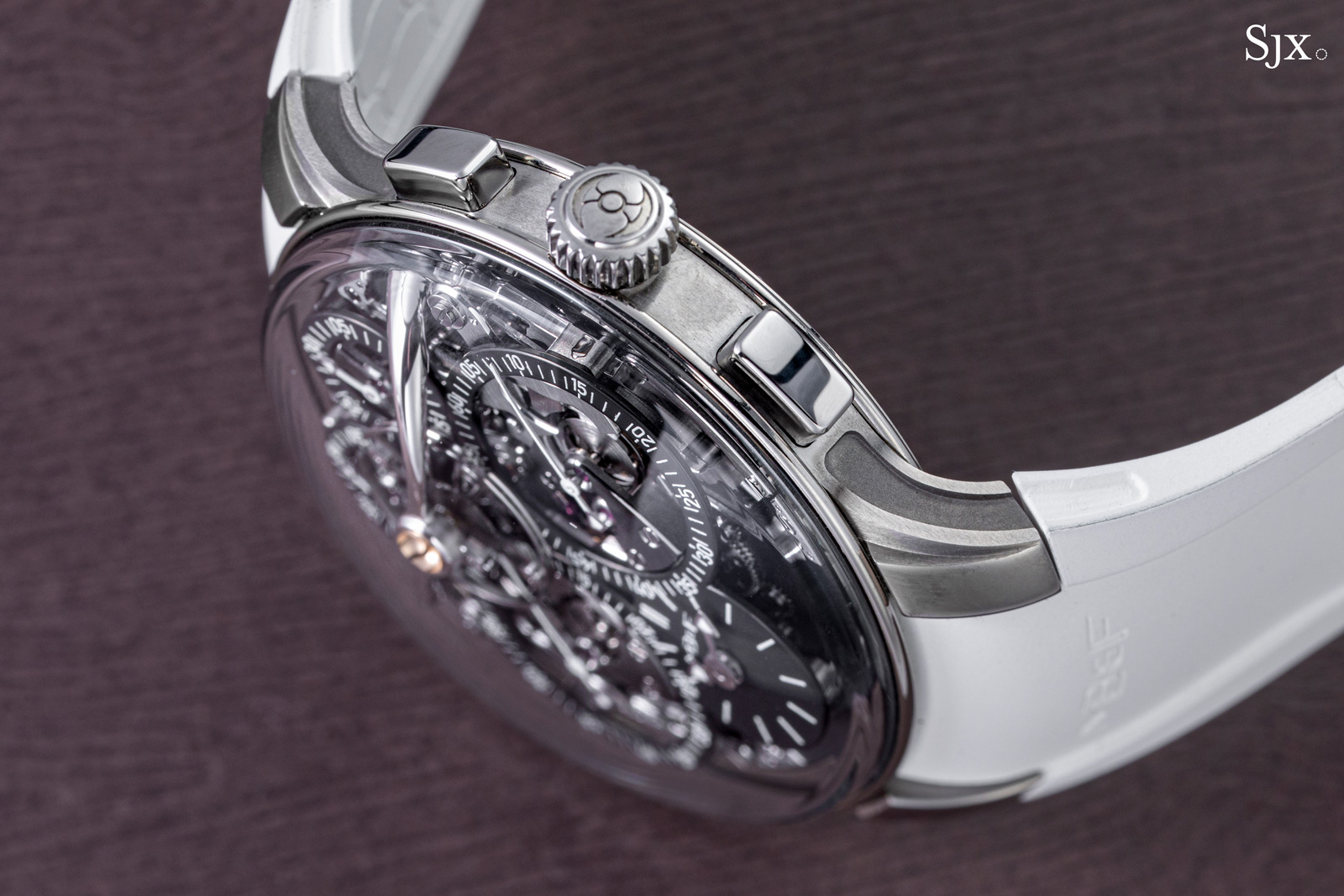
In short, the Sequential EVO has all of the key qualities of its perpetual calendar predecessor – namely the EVO styling and sporty case – but goes one better with the newly-developed movement.
The Sequential EVO has the same diameter as the perpetual, but is slightly thicker at 18.2 mm, making it a big watch overall. That said, most of the height is due to the domed crystal, with the actual case accounting for only about half of the total thickness.
Despite the width and thickness of the case, the LM Sequential EVO has surprisingly good ergonomics. It is easily wearable and sits comfortably, with the arched lugs and downswept strap helping it cling to the wrist.
The LM Sequential EVO is available in two dial colours, both the result of PVD coating – the sharp-looking “atomic orange” and the more neutral “coal black”. Both make a statement on the wrist by virtue of the size and style of the watch, but the orange dial allows the chronograph mechanisms to stand out more visibly, resulting in a more striking appearance.
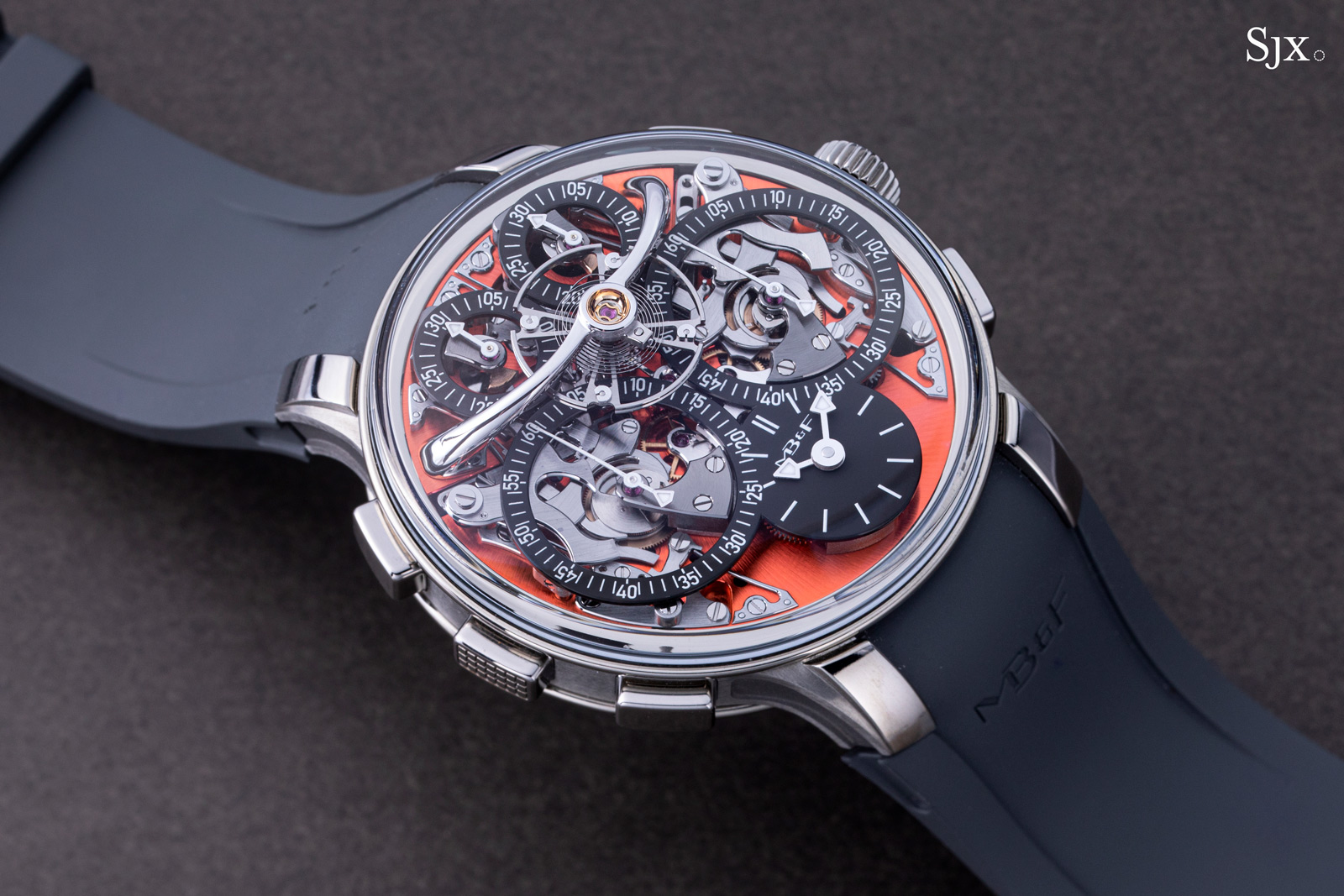
“Atomic orange” dial paired with a black strap
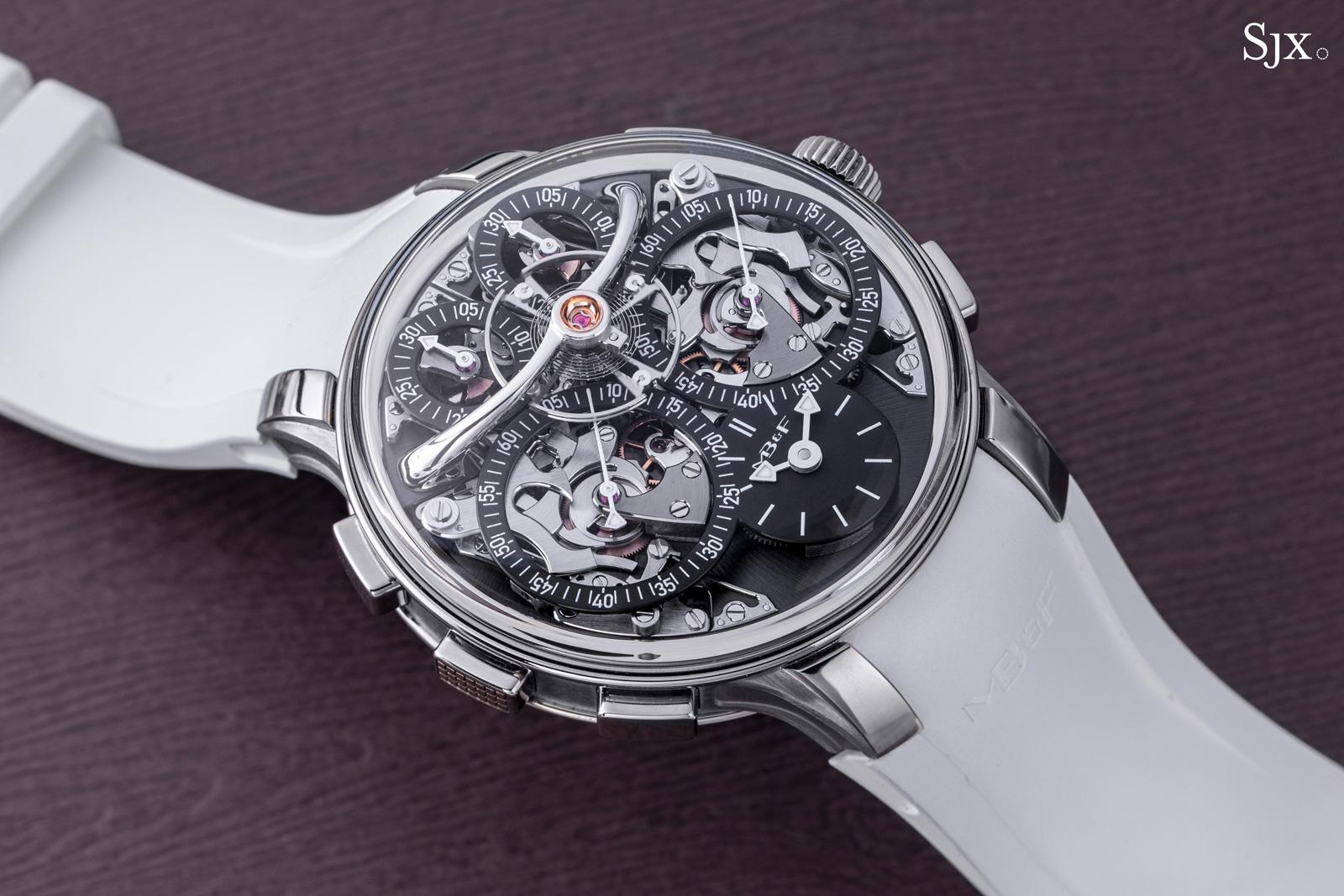
“Coal black” with a white strap
Twin chronographs
Of course, the highlight of the LM Sequential EVO is the complication, or rather, complications – a pair of vertical-clutch chronographs, arranged symmetrically on the left and right halves of the dial. In fact, the chronograph mechanism occupies practically the entire dial, leaving only a tiny sub-dial at six o’clock to display the hours and minutes, almost as an afterthought.
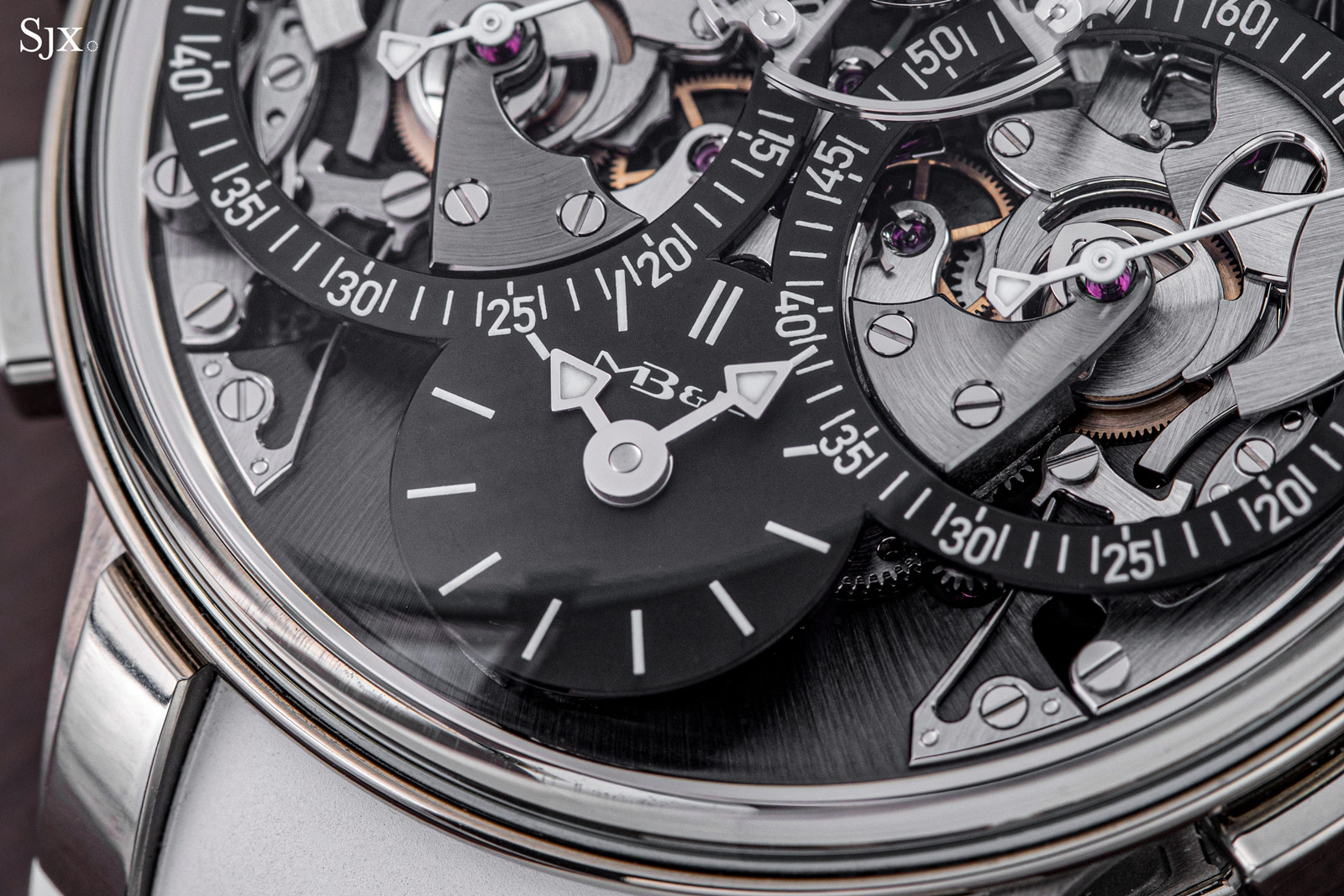
The time display, occupying only a tiny portion of the dial
The choice of a vertical clutch for each chronograph is sensible as it avoids the erratic starting of the chronograph hand that sometimes happens with lateral-clutch constructions. Additionally, a key feature in the construction of the twin chronographs emphasised by Mr McDonnell is the vertical clutch integrated into each going train – this will be explained in detail below.
Each of the two chronographs has its own set of start-stop and reset pushers, explaining the buttons on both sides of the case. Both function exactly like a typical chronograph.
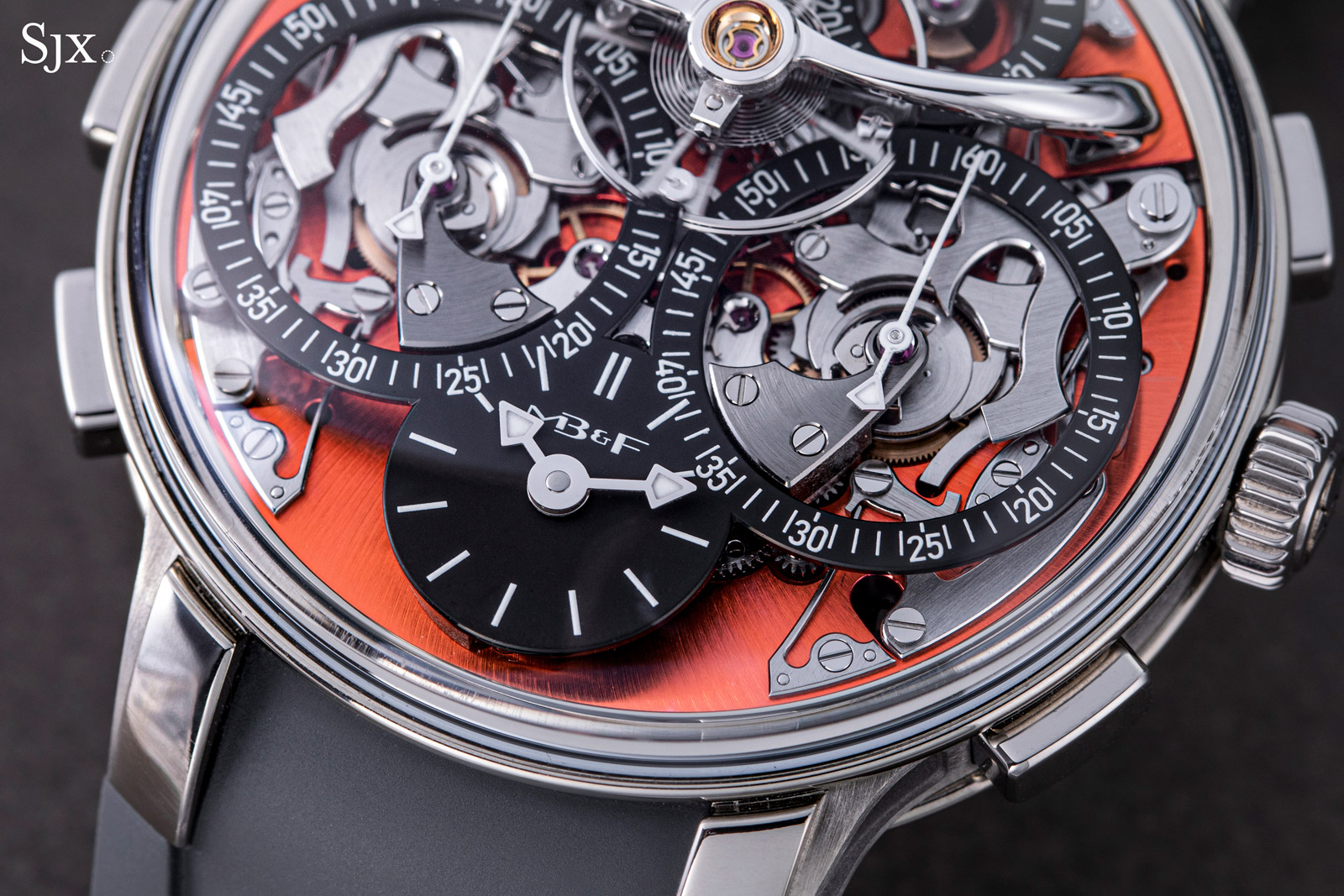
The pushers on the right side of the case control the chronograph mechanism on the right: the pusher at two o’clock starts and stops of the right-hand chronograph via a column wheel, while the pusher at four o’clock resets it.
Everything is mirrored on the opposite half of the watch, with the pushers at ten and eight o’clock controlling start-stop and reset functions respectively of the left-hand chronograph.
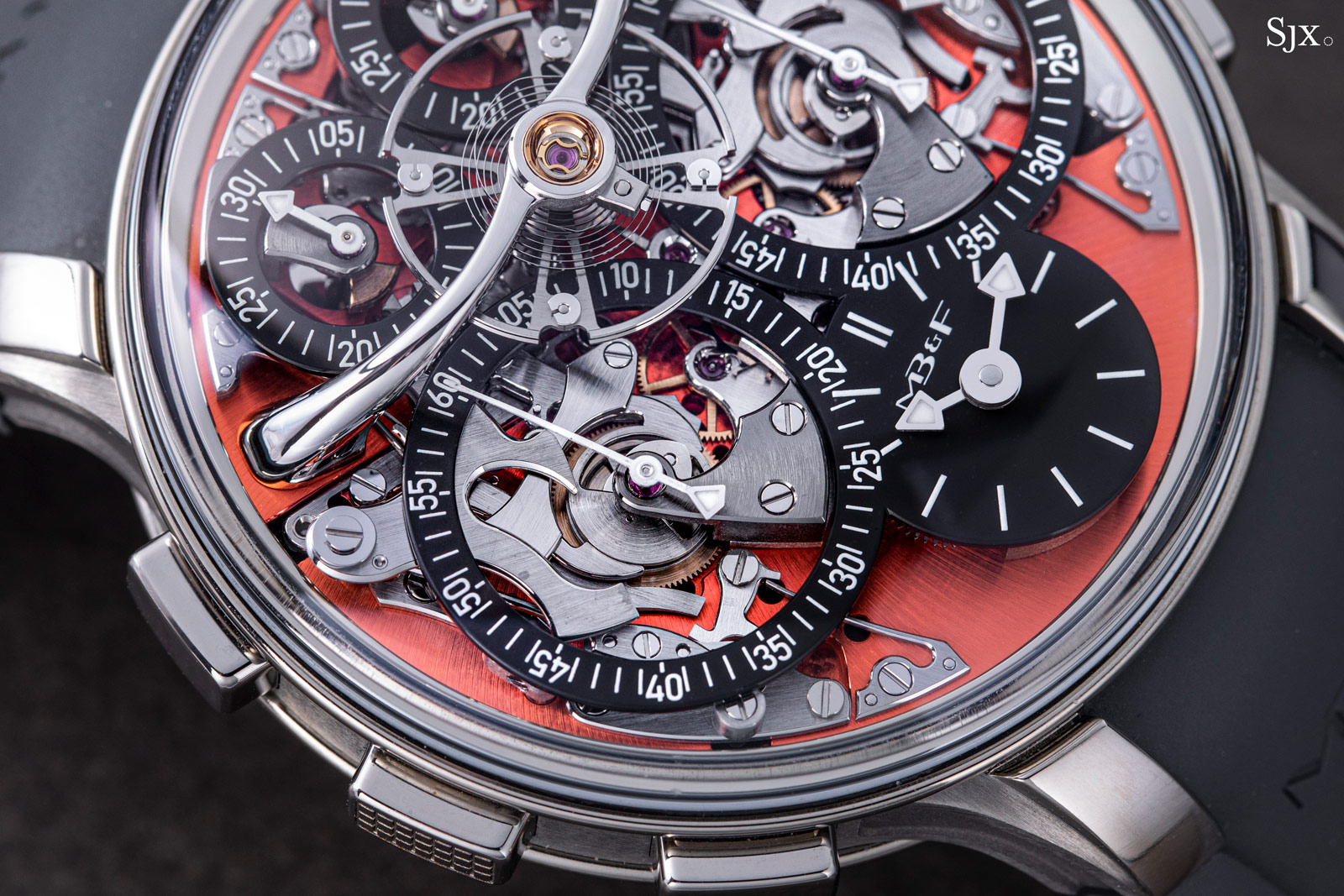
The lefthand chronograph with its oversized seconds register
Because the Sequential EVO wants do more than a conventional split-seconds chronograph, it has to make do with two smallish sub-dials for the elapsed seconds. Each of the chronographs has an oversized 60-second register to record elapsed seconds but they aren’t wide enough to accommodate the fraction-of-a-second hashmarks that are standard on most chronographs, making it more difficult to read time measurements precisely.
The seconds registers go along with a smaller, 30-minute totalisers positioned at top of the dial. Both minute counters have continuously sweeping hands, instead of being the semi-instantaneous jumping hands found in most chronographs, a detail that will be explored in detail below.
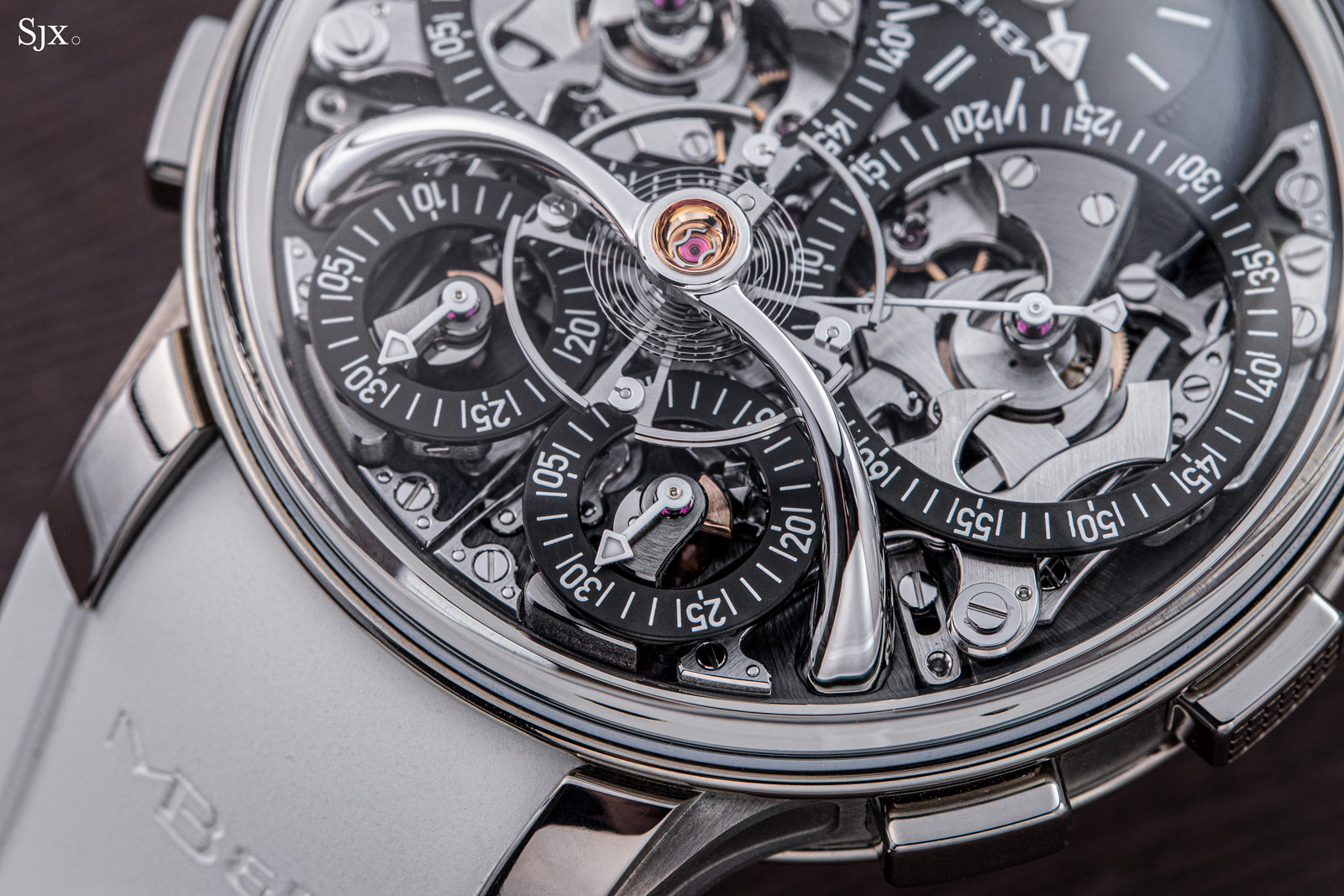
The two 30-minute counters for each chronograph that sit below the balance wheel
Each of the two chronographs can be operated independently since they are mechanically independent. But that alone would not be very interesting. The novelty lies in the fifth pusher located at nine o’clock that controls the Twinverter mechanism.
The Twinverter is essentially a two-in-one pusher that simultaneously actuates the column wheels of both chronographs – toggling the on and off functions for each at the same time. But the result of activating the Twinverter depends on the current state of the respective chronograph.
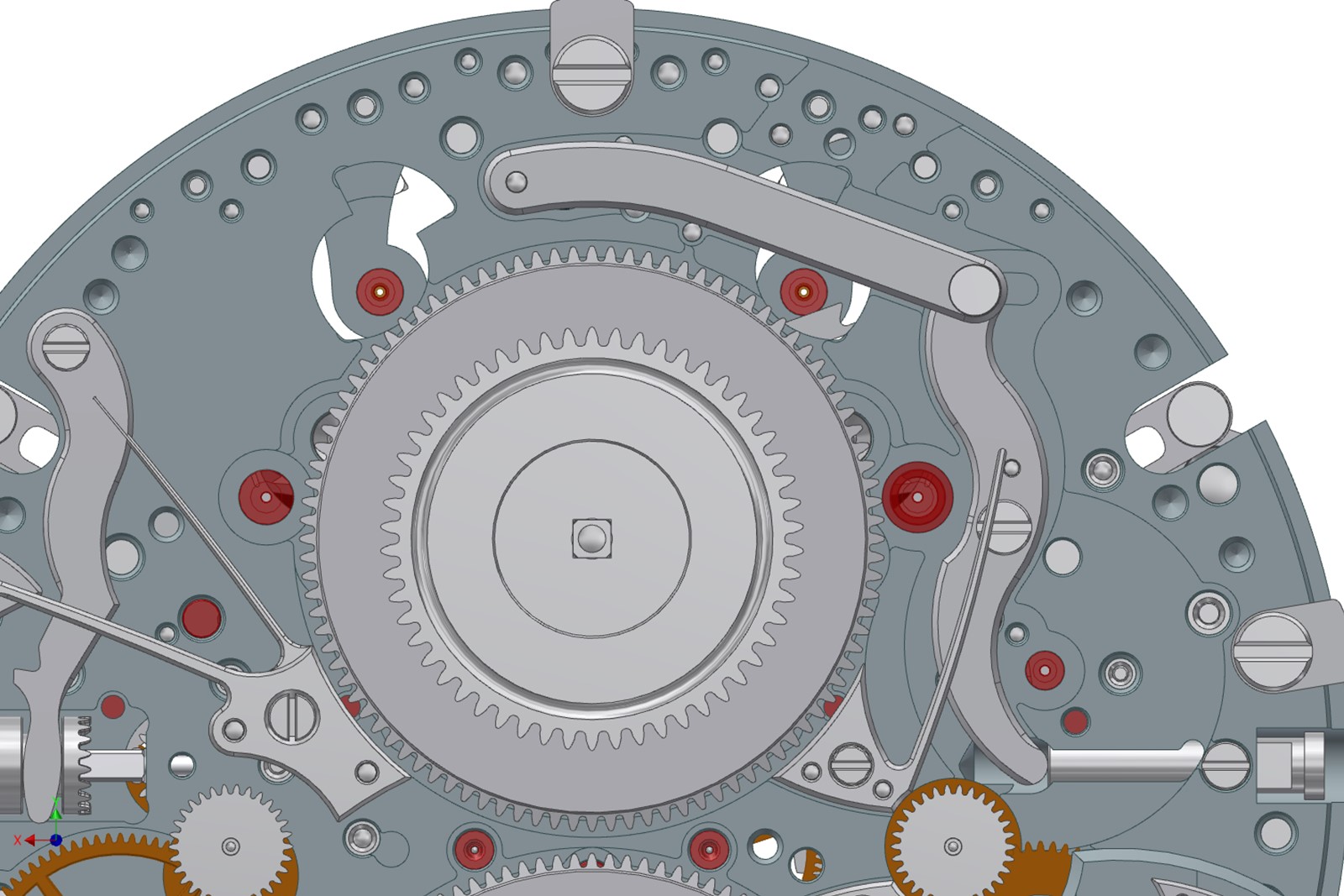
The Twinverter pusher operates a lever hidden under the movement going trains on the movement case back side
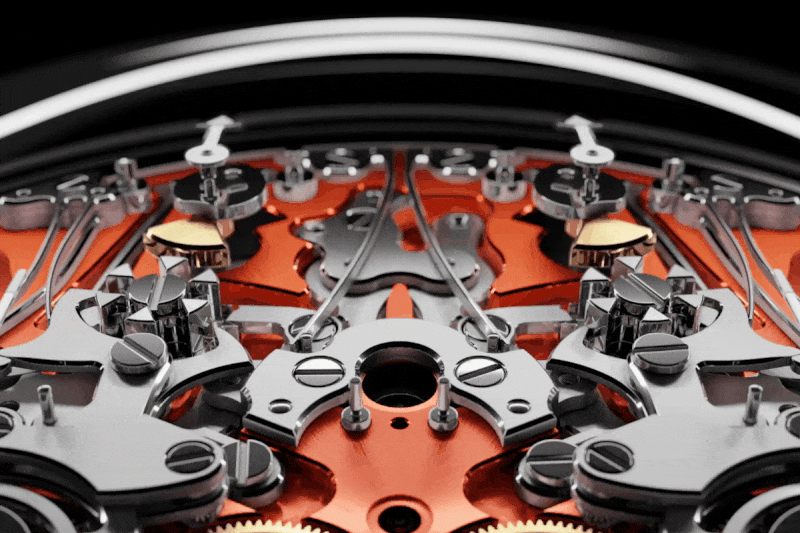
The Twinverter pusher actuates a set of mirrored levers which simultaneously impulses both column wheels a notch forward
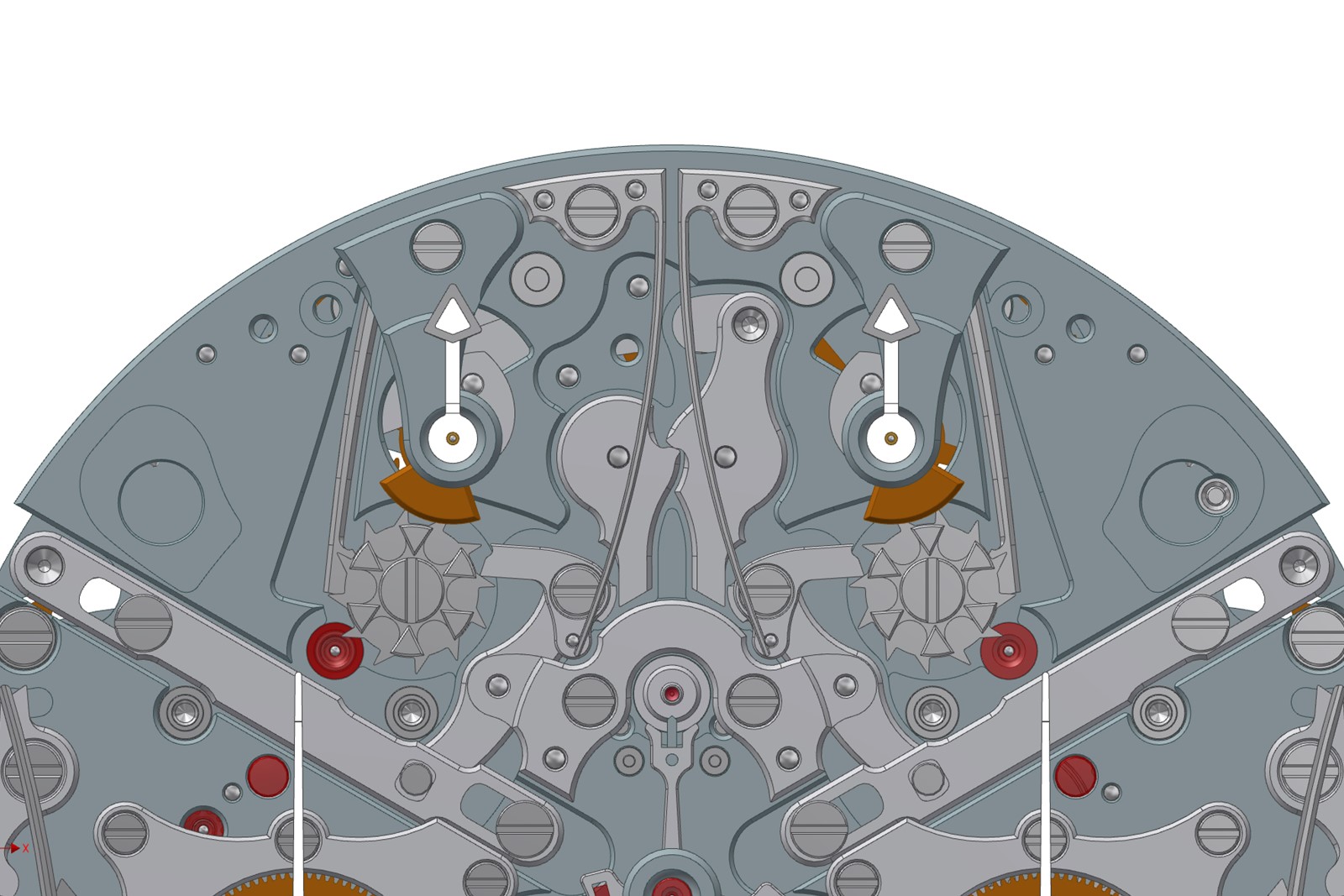
Either the Twinverter or the straight operating levers of the regular chronograph pushers can actuate the column wheelsIf both chronographs are off, the Twinverter will start both simultaneously, so both seconds hands will start running at the same time. But if only one chronograph is running, while the other is disengaged, then the Twinverter will stop the running chronograph, while starting the inactive chronograph – it inverts the state of each chronograph.
Since the Twinverter simply changes the on-off status of each chronographs – it is mechanically separate from the chronograph mechanisms – any subsequent use of the chronograph pushers will operate the chronograph as normal. If the Twinverter is used to invert the states of each chronograph, for instance, then running chronograph can be stopped and reset immediately after, restoring both chronographs to the same inactive state.
But the addition of the Twinverter brings with it the need for a safety mechanism to deal with a scenario where the pushers for Twinverter and chronographs are simultaneously activated, which might jam the column wheel mechanism.
The solution is an intermediate lever mechanism for each column wheel, which was inspired in part by the safety mechanisms within the LM Perpetual (that prevent inadvertent setting of the calendar causing damage to the mechanism). Pushing either the Twinverter or a chronograph pusher will pivot the lever, which in turn impulses the respective column wheel while simultaneously decouples the other pusher.
As a result, holding down the Twinverter pusher disables both chronograph pushers. Conversely, with one of the chronograph pushers is held down, activating the Twinverter only engages the other chronograph mechanism.
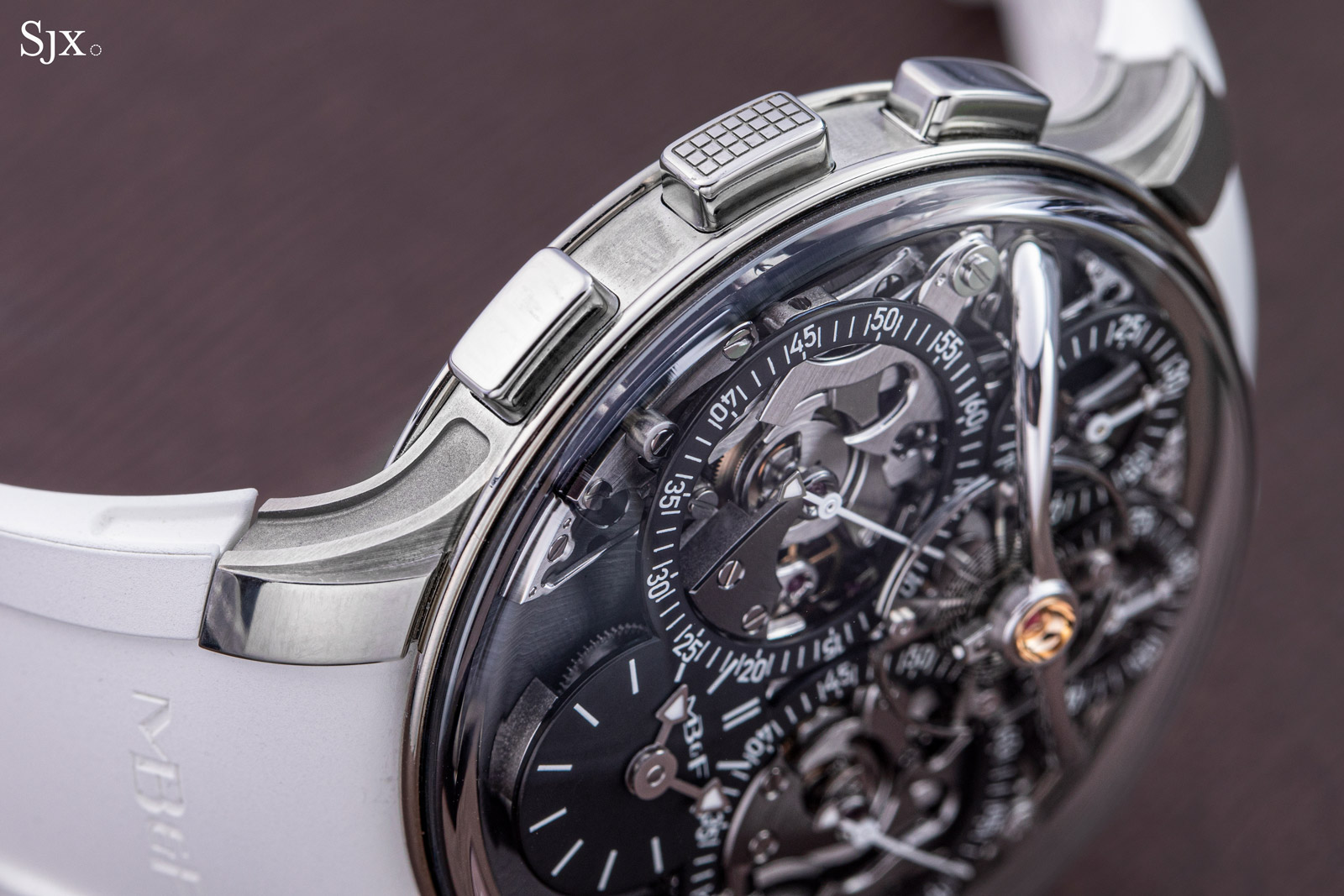
The Twinverter pusher has a chequerboard engraving on its top to set it apart from the other, identically-sized pushers
The Twinverter lends to some interesting additional functionality to the chronograph(s). Both can be simultaneously started to time two separate events that begin at the same time, giving the watch a functionality similar to that of a split seconds or rattrapante – but one extended to have the capability of independently measuring twin elapsed times of up to 30 minutes each.
Or, in a more specific application, the watch can be used as a chess clock: opponents in a chess match can be each timed by alternating the start and stop of both chronographs via the Twinverter.
The flexibility functionality is undoubtedly useful and is only limited the applications that require such a watch. The versatility is impressive, as is the novel concept.
Admittedly, the two-chronograph concept itself feels uninspired, since it essentially doubles the mechanics to accomplish double the result. But upon closer study, the execution of the concept is refined, thoughtful, and clever. It employs many elegant techniques to integrate everything within an unusually small space, allowing almost every bit of space within the movement to be fully utilised.
For instance, the sub-dial for the time display requires numerous intermediate wheels to relocate it to 6 o’clock. Furthermore, an additional set of intermediate wheels for time setting via the keyless works are needed, with just enough space available to snake around the vertical clutch of the right chronograph.
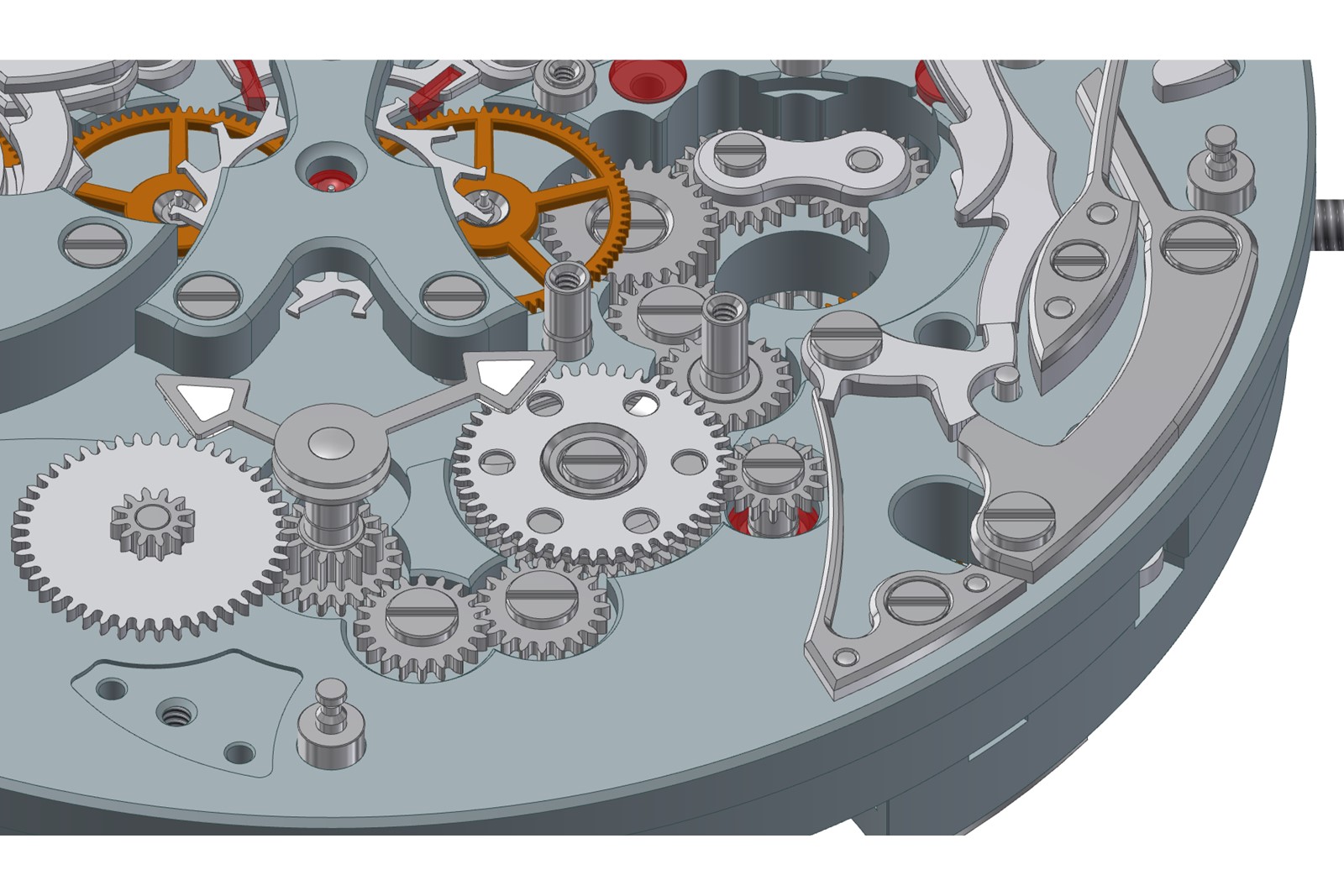
Twin going trains
Powering the twin chronographs calls for an unconventional base movement. Here it takes the form of two identical going trains leading to a single escapement.
Most of the space below the dial is occupied by two large barrels, each powering separate going trains arranged in 180° rotational symmetry (in other words, the going train from the upper barrel travels downwards, and vice versa for the lower barrel). The barrels are arranged vertically from six to 12 o’clock, an arrangement that is perpendicular to the horizontal symmetry that characterises the dial design on the front.
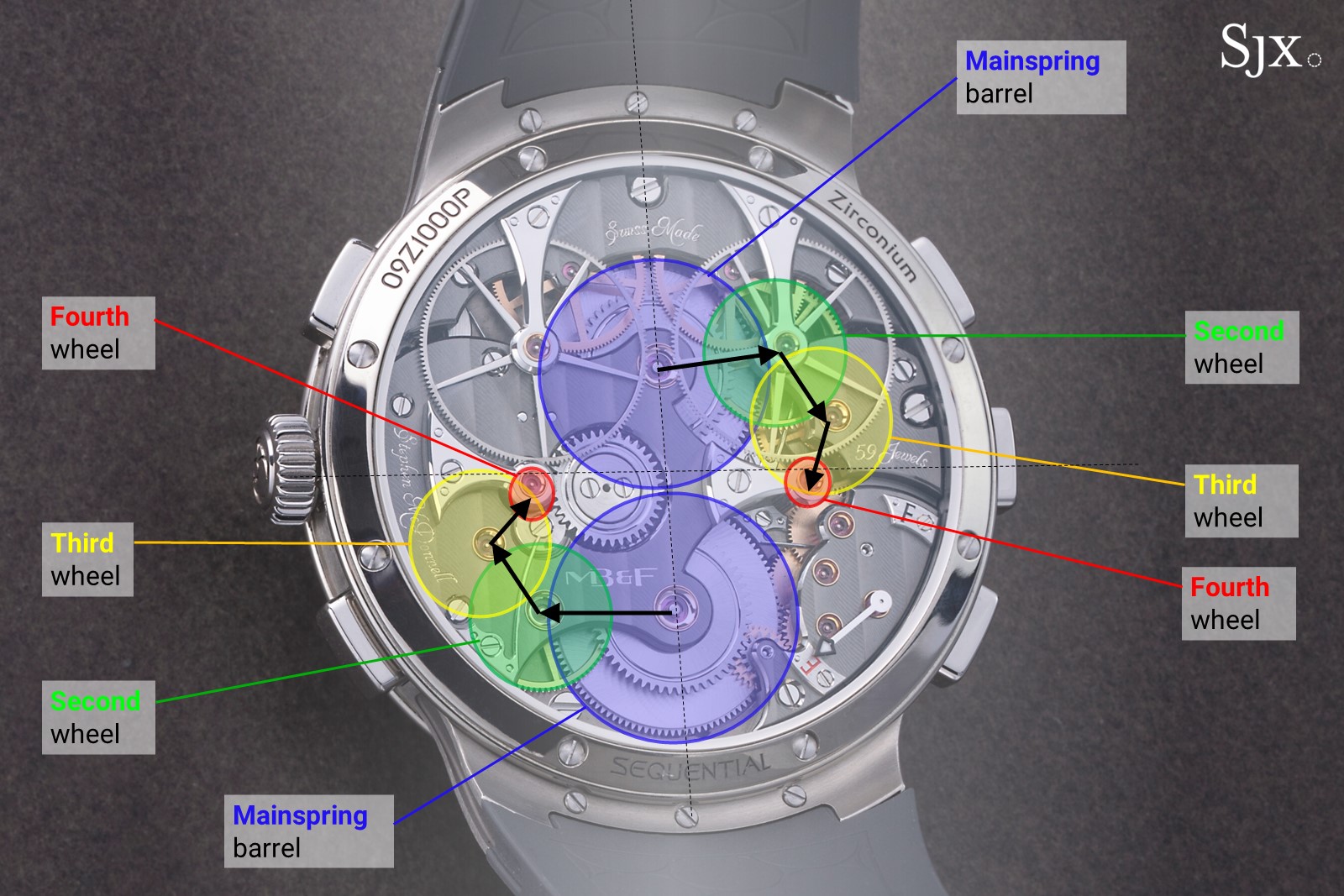
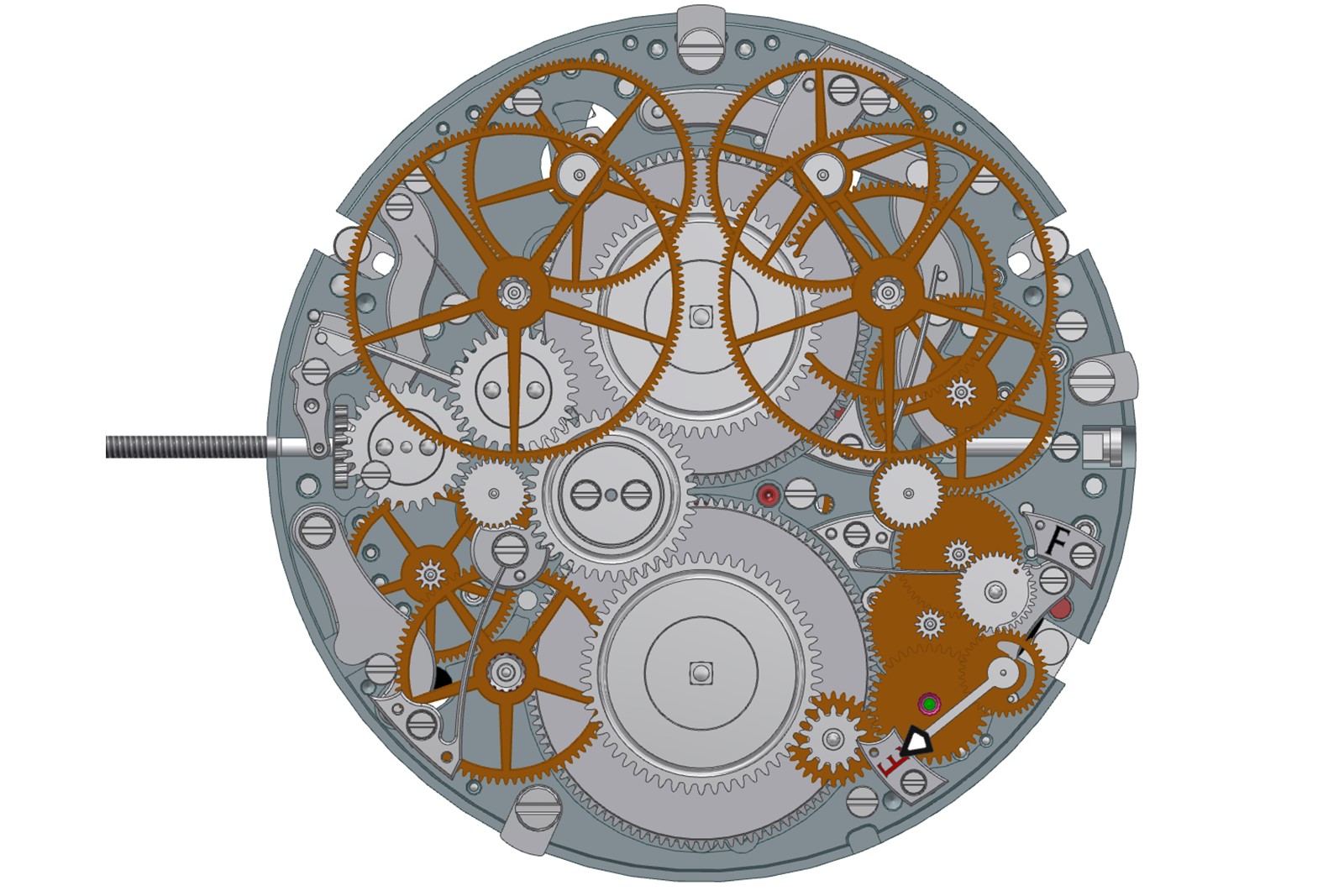
Interestingly, the barrels differ in size as the diameter of the upper barrel is limited by the position of the minute counter and its intermediate wheels. The lower barrel has no such constraint, so it was made slightly bigger to maximise power reserve and fully utilise the available space. Another quirk is the fact that both barrels are slightly displaced and positioned closer to the bottom of the movement to make room for the minute counters on the top.
Having two barrels of differing sizes creates its own problem, as both going trains are linked by a common escape wheel. Since the ratchet wheels winding each barrel are the same size, both barrels wind at the same rate and also fully unwind with the same number of turns. This meant that the size and number of teeth on the barrels as well as each going train had to be modified to achieve the correct gear ratios.
Consequently, the bottom barrel has more teeth than the top barrel. This means that the third wheel of the lower going train has a smaller diameter, and hence fewer teeth, to compensate for the additional teeth on the barrel – providing the same gear ratio necessary for matching both going trains.
The asymmetrical gear train also serves an another purpose – the reduced diameter of the third wheel allows means just enough space leftover for reset pusher located at four o’clock that controls the right-hand chronograph. This matters due to the requirement that the pushers sit on the same level as the crown. That in turn called for slightly different reset levers for the left and right chronographs, as the reset lever for the right chronograph has to snake its way around the third wheel.
Both going trains drive a fourth wheel located on the dial side, which in turn drives a single escape wheel located at the centre of the movement partly due to the rotational symmetry of the movement, but also due to a design characteristic of the LM series, namely the elevated balance wheel positioned near the centre of the dial and supported by a polished, V-shaped steel bridge.
The balance wheel has an elongated balance staff that allows it to sit above all of the chronograph elements, while the escape wheel sits near the surface of the dial.
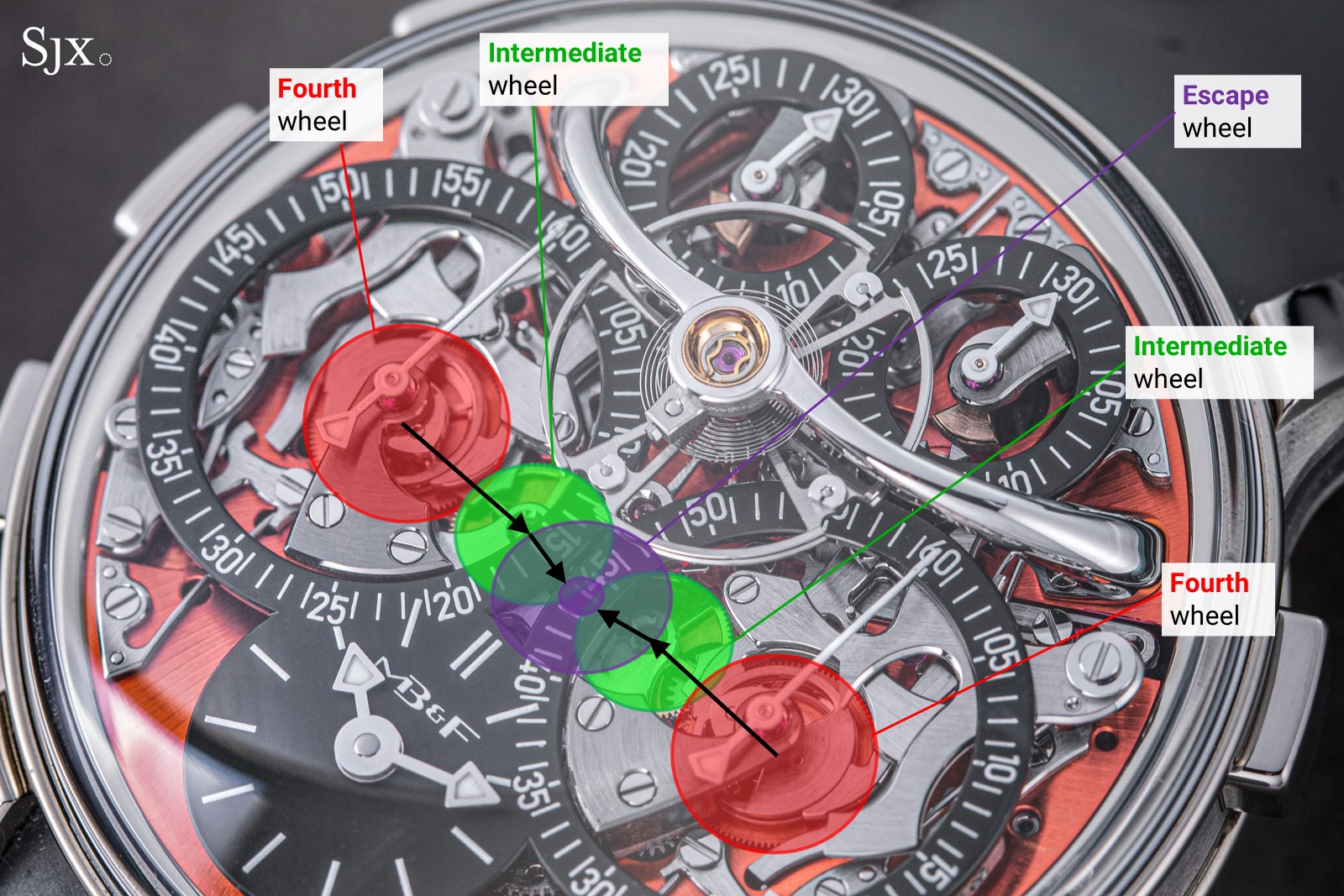
To prevent erratic loads on the chronographs, the minute totalisers are continuously sweeping instead of being the typical semi-instantaneous jumping design. Each minute totaliser are driven by a wide intermediate wheel in turn driven by the pinion of the vertical clutch. The unusual configuration of intermediate wheels on the back for the chronograph instead of the front is likely due tight space on the dial, which is already occupied by the chronograph levers and vertical clutches.
The reason for the unusually large diameter of the intermediate wheels is the 1:30 reduction gear ratio needed for a correct elapsed time display, namely one revolution of the chronograph seconds wheel advances the elapsed minute hand by 1/30th of a revolution.
Because of their size – each intermediate wheel is almost the radius of the entire movement – the twin wheels are a visual highlight of the case back view. Wheels of this size with such fine spokes are rare, save for relatively obscure movements with esoteric complications.
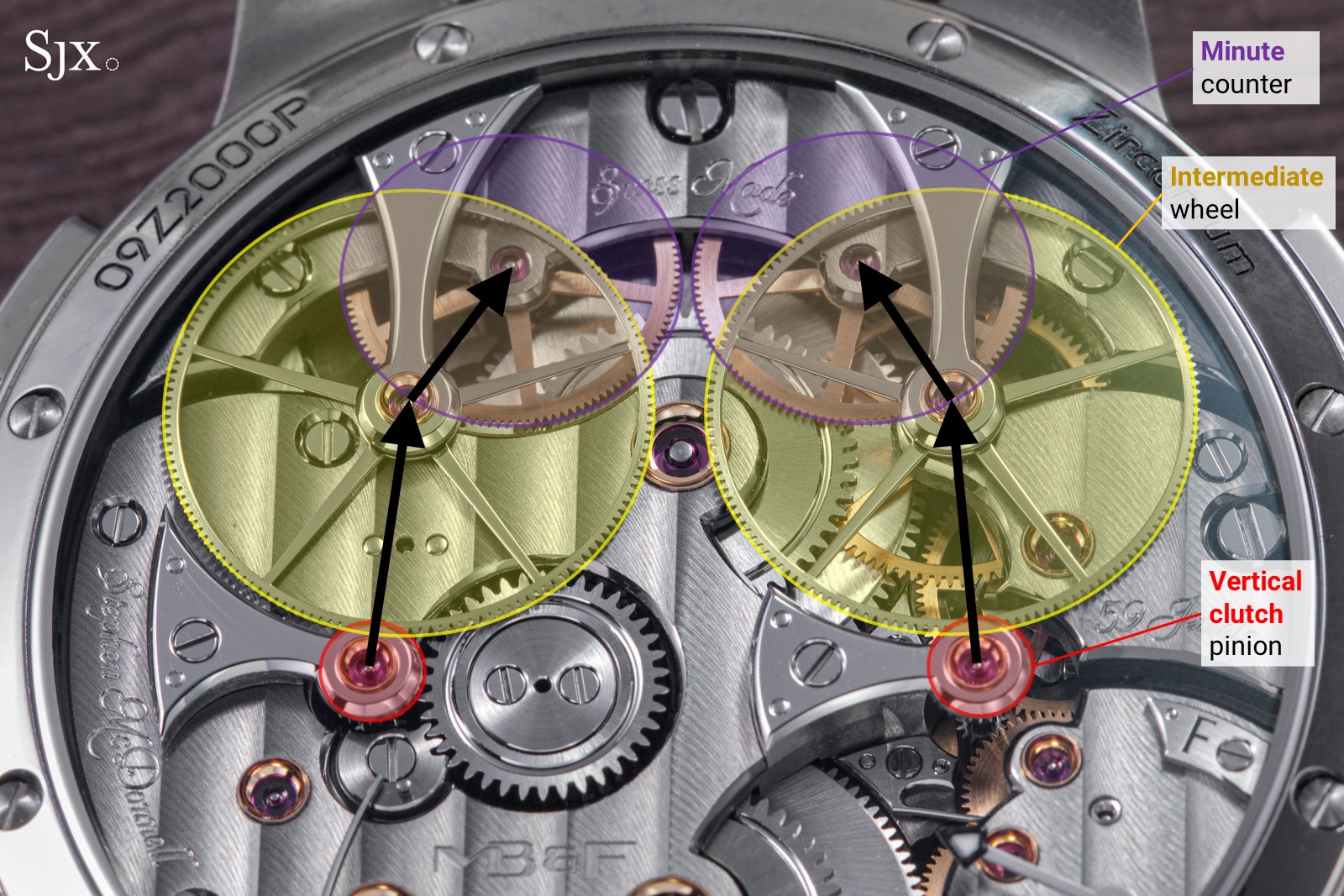
But the crucial element of the movement construction remains the unconventional setup of two identical going trains, a consequence of the twin chronograph mechanisms. Each fourth wheel becomes an integral component of the vertical clutch of each chronograph, while also driving the elapsed seconds.
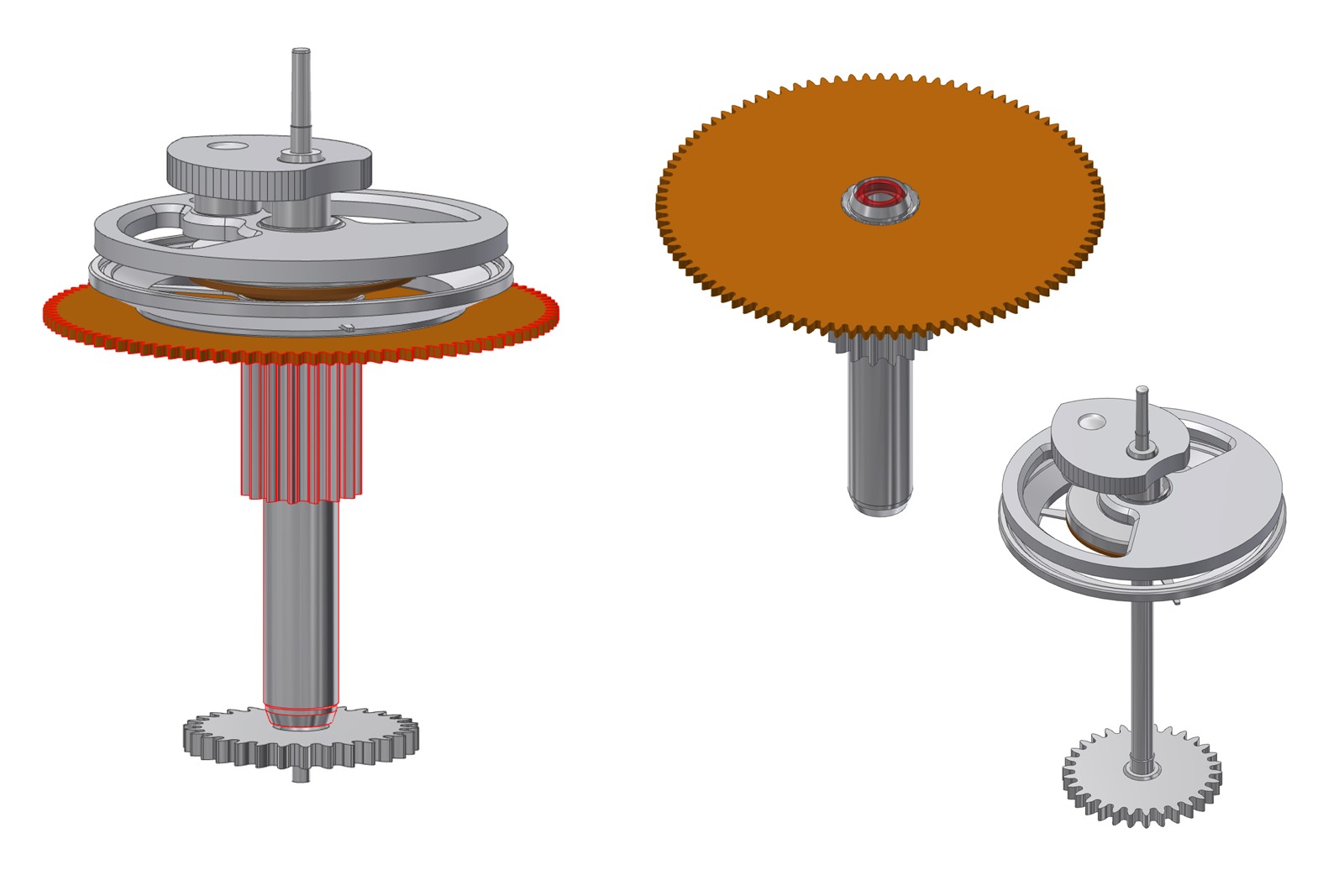
The vertical clutch in the Sequential EVO has the fourth wheel (in brass) integrated as the mating surface of the clutch, avoiding the need of auxiliary geartrains
This setup avoids the need for auxiliary gear trains since the vertical clutches are directly driven, which eliminates potential backlash in both going trains. That results in a smoother motion of the chronograph seconds hand, since there is no backlash or play in the gear train that drives it. Put another way, each chronograph is directly driven by its own gear train.
Conversely, most conventional vertical clutch chronographs have the vertical clutch driven as an auxiliary gear train. As an auxiliary gear train is not under continuous load, a vertical clutch will require a tension spring that induces an artificial load to avoid seconds hand “stutter”, or jerky motion of the hand. This is not ideal due to the extra friction induced by the tension spring.
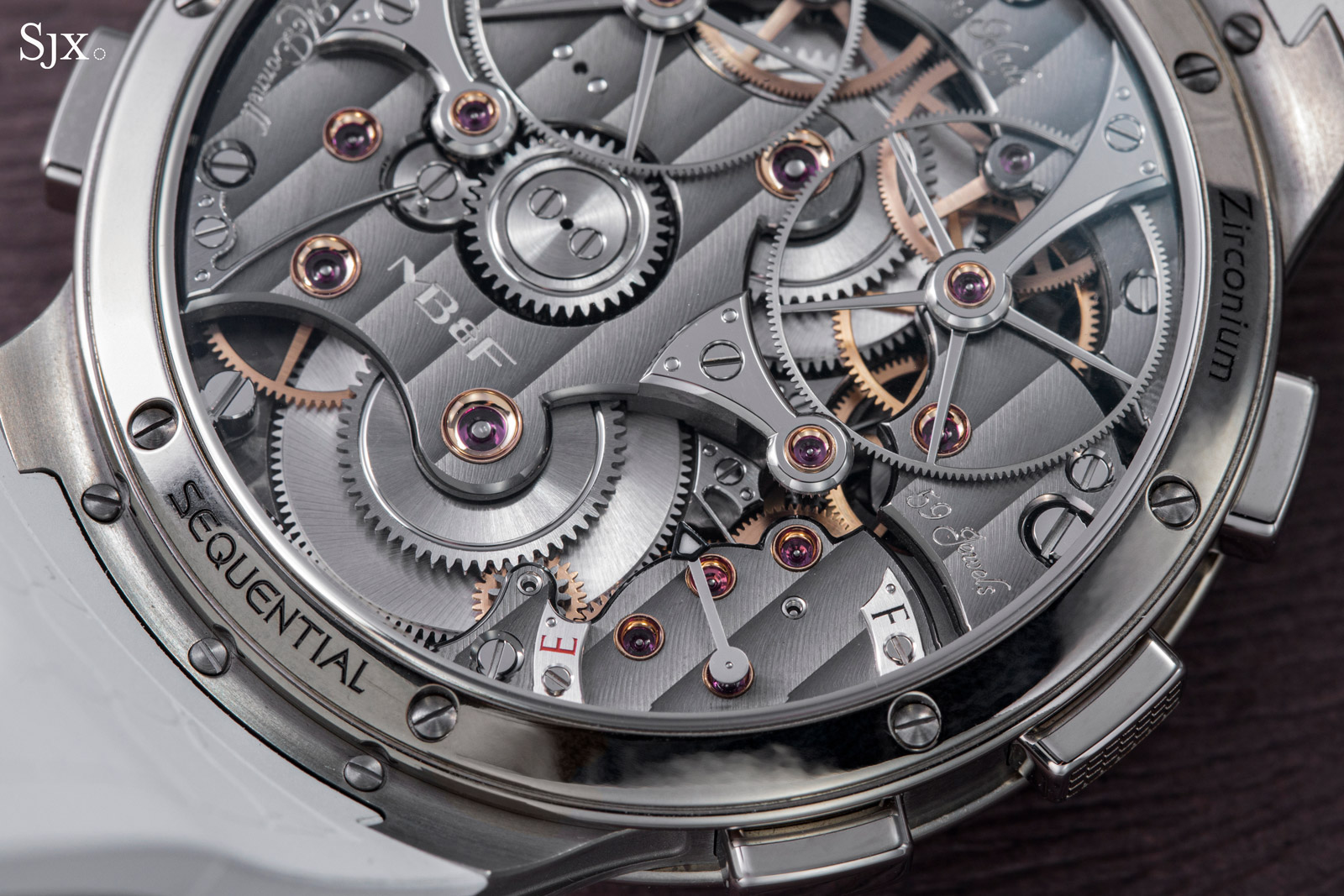
Another crucial aspect of the design of the Sequential EVO movement was managing the internal friction between the concentric shafts of the vertical clutch – a point Mr McDonnell stressed was vital to ensure the movement functions properly.
To understand why it was vital, we have to understand the basics of the vertical clutch. It has a continuously driven wheel that engages with the chronograph seconds wheel (much like a manual transmission of car) when the chronograph is started. By design, this chronograph seconds is mounted on a steel shaft, which in turn sits within a larger, hollow shaft that is connected to the continuously driven wheel. When the chronograph is not running, the chronograph seconds wheel is stationary and generates friction with the rotating hollow shaft –resulting in an increased load on the vertical clutch when the chronograph is stopped.
The Sequential EVO addresses this with jewelled vertical clutch. Two jewelled bearings are installed within the vertical clutch, preventing metal-to-metal contact of the concentric shafts and minimising friction. The two jewel bearings are installed into recessed ends on both sides of the hollow shaft, with the raised lips on the shaft then burnished inwards to set the bearings in place. This method, similar to gem-setting techniques used for jewellery, was necessary because steel is a hard enough alloy that jewel bearings cannot be pressed into the metal, as they can with softer alloys like brass or German silver.
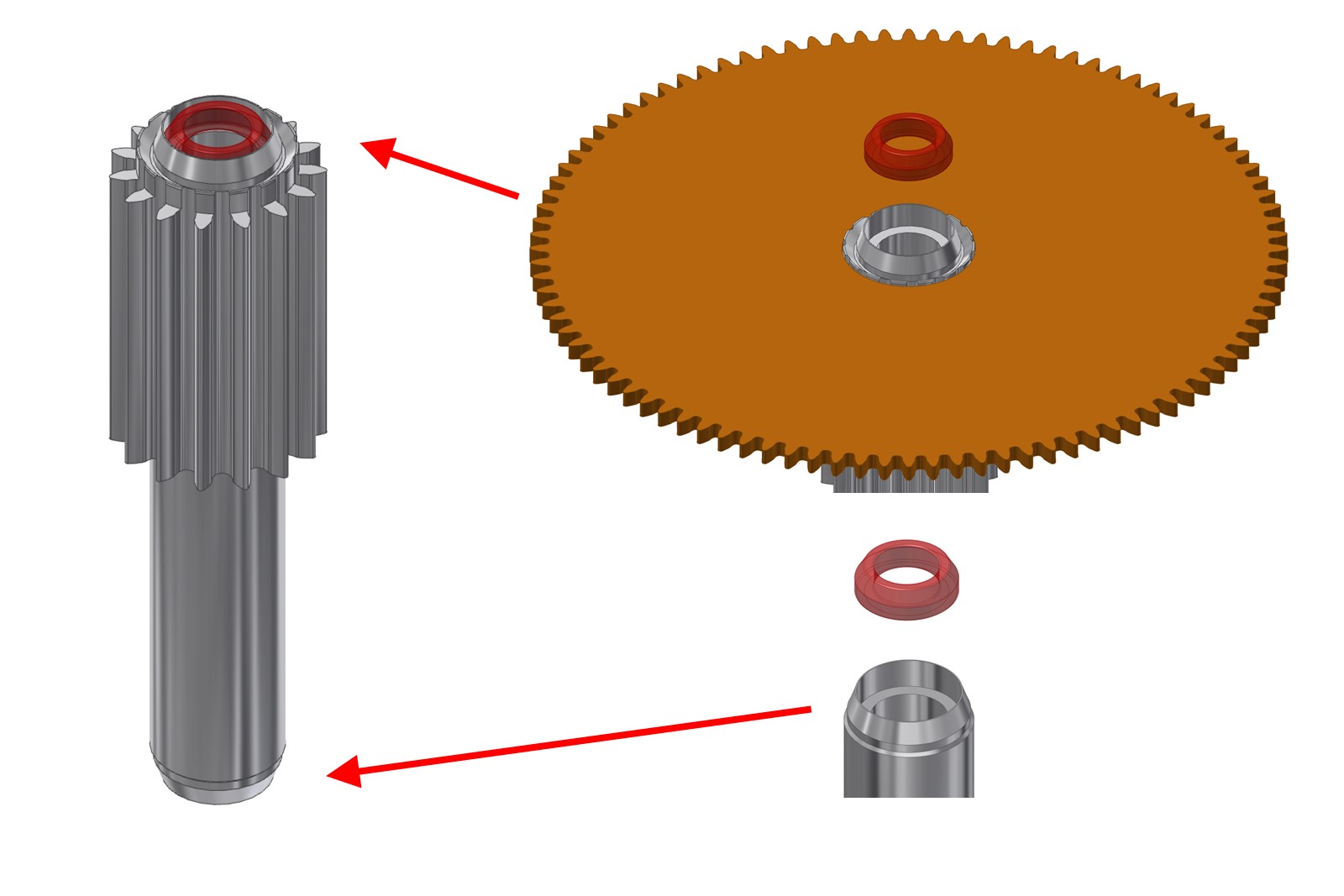
The steel hollowed shaft of the vertical clutch has two jewel bearings set into both ends of the shaft in recesses
Cumulatively, this creates a chronograph that has little load variation between its start and stop states, thanks to the jewelled clutch and the continuously sweeping minute totalisers. And with the optimised barrel sizes, the Sequential EVO achieves an impressive 72-hour power reserve. Conveniently, the state of wind is indicated by a power reserve displayed on the back, which utilises the otherwise unoccupied space at the bottom right of the movement.
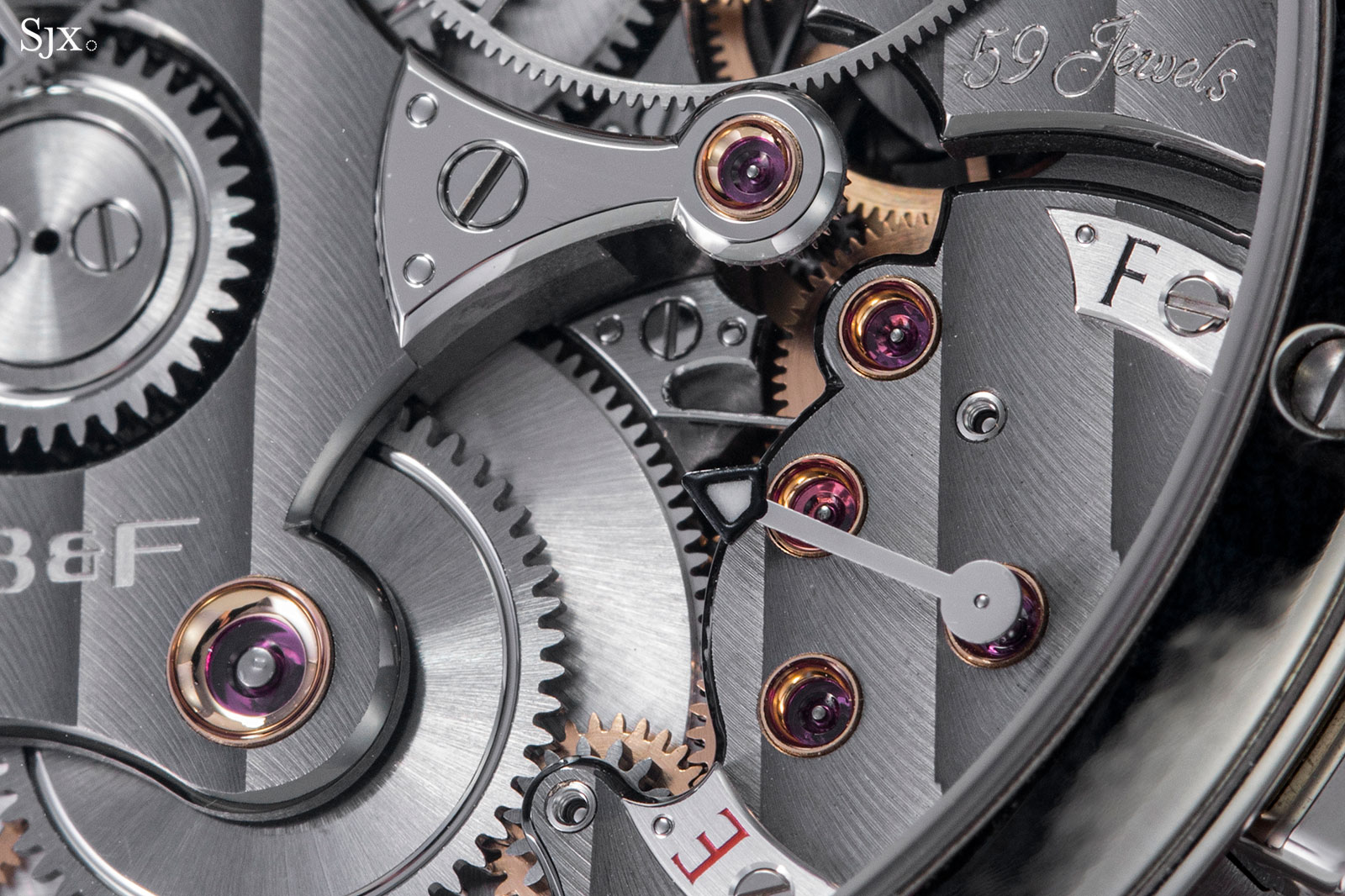
The power reserve indicator with its “empty” and “full” labels
Finishing
Similar to that found on other LM watches, the movement finishing of the Sequential EVO is carefully and neatly applied in a manner that is consistent in both quality and aesthetics. Put more simply, the decoration is well done.
The open-worked dial presents itself with a dense assembly of exposed steel parts that illustrate the quality of decoration well. The many steel levers of both chronograph mechanisms sport straight-grained top surfaces matched with polished bevelling around the their edges.
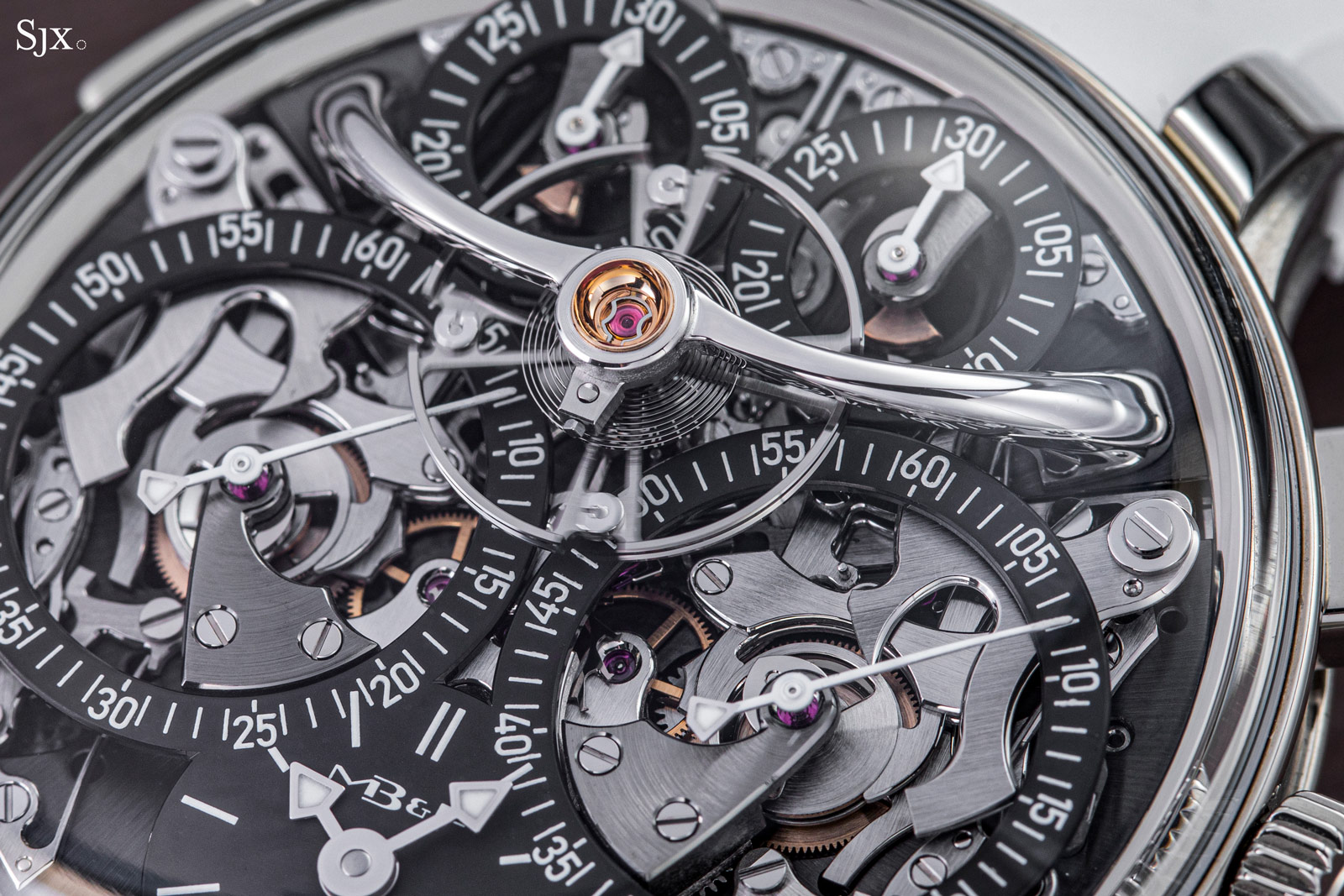
The thin construction of the chronograph mechanisms means the levers lend themselves especially well to this finishing, as the fine straight graining on the levers can be easily admired
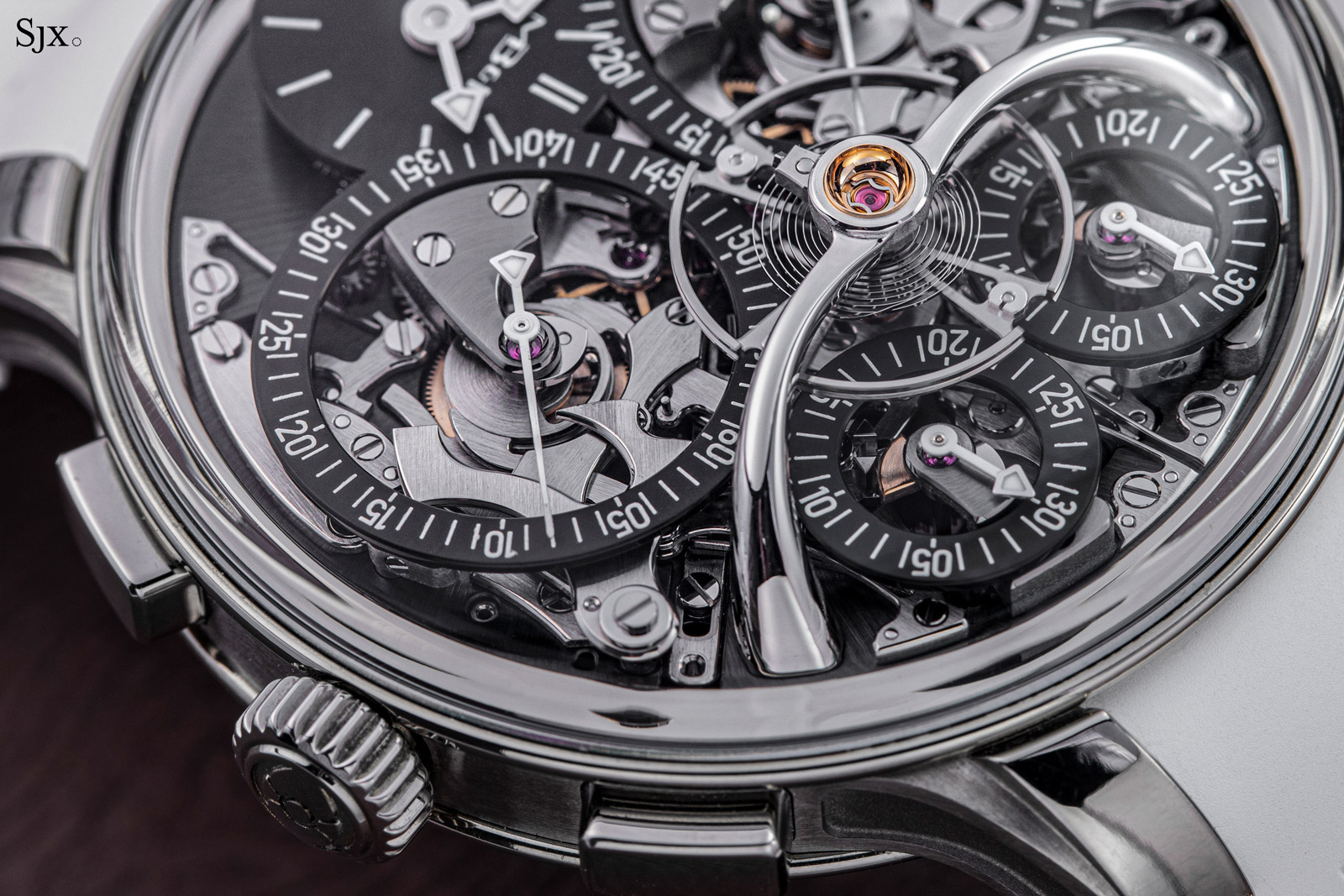
A hallmark of all LM watches, the arched balance bridge is rounded and polished
Deserving of special attention are the large, pincer-shaped reset hammers that each have a wide, concave region exhibiting broad, mirror-polished anglage that especially fine.
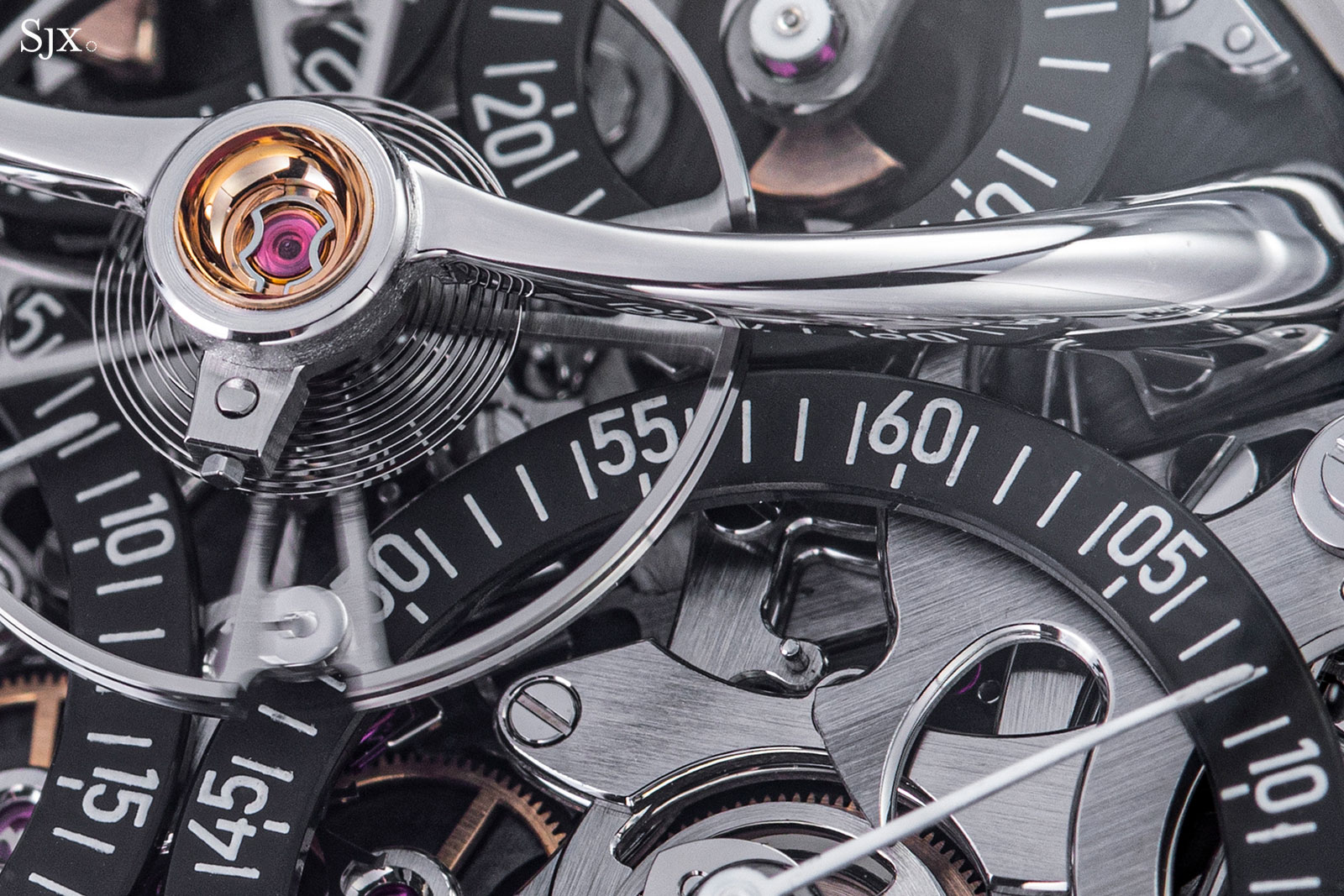
Admire the wide, rounded bevelling on the reset hammer (at bottom right)
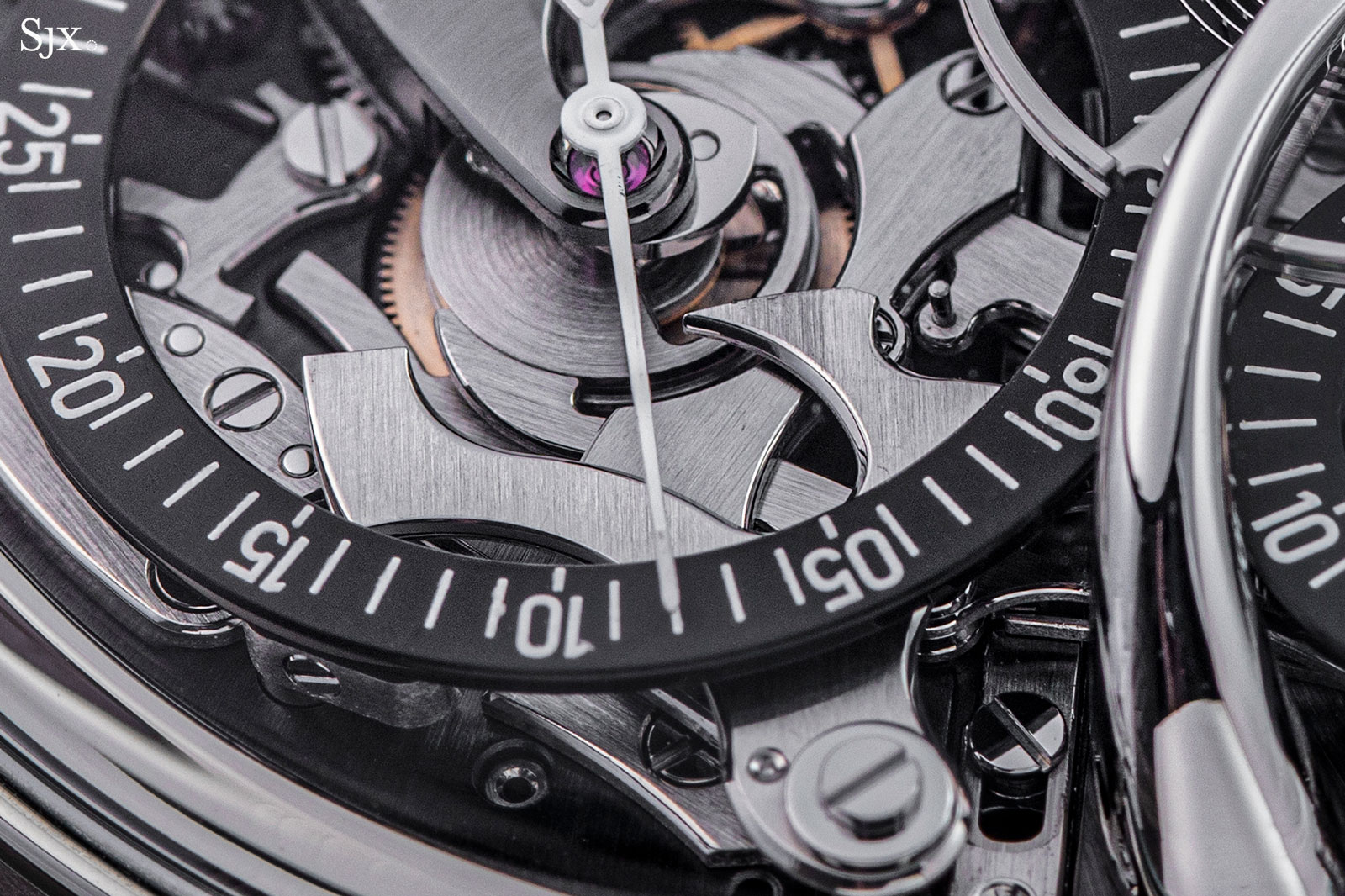
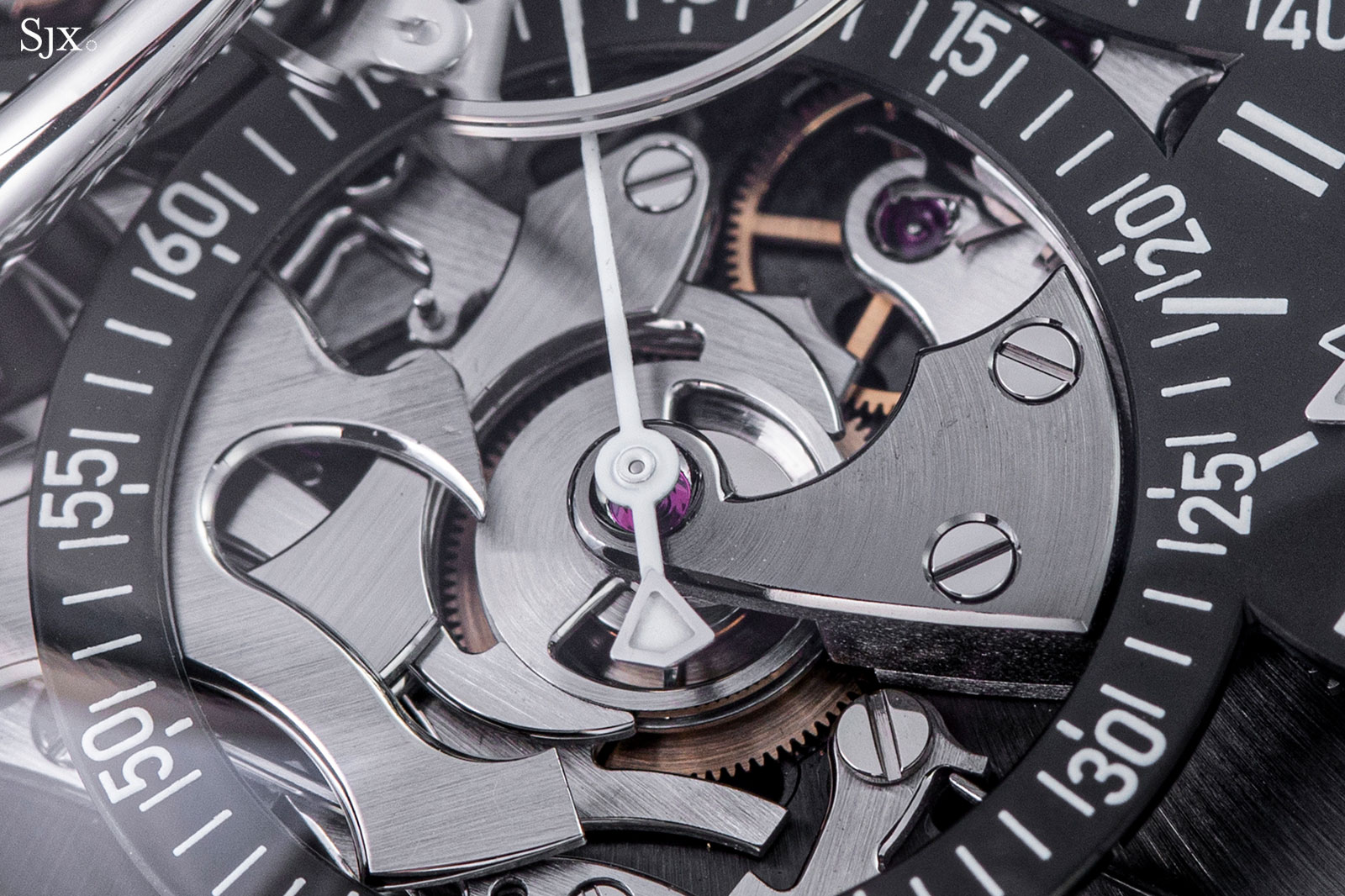
The bridge for the elapsed seconds hand is equally well finished
On the back, the typical LM aesthetics can be observed as well. The bridges are finished with neat anglage that’s been polished by hand, as evidenced by the numerous, well-defined inward and outward angles that reveal no traces of milling.
Another trademark element of LM movements, the gold chatons that secure some of the jewel bearings add a touch of contrast to the otherwise monochromatic appearance of the dark rhodium-plated bridges.
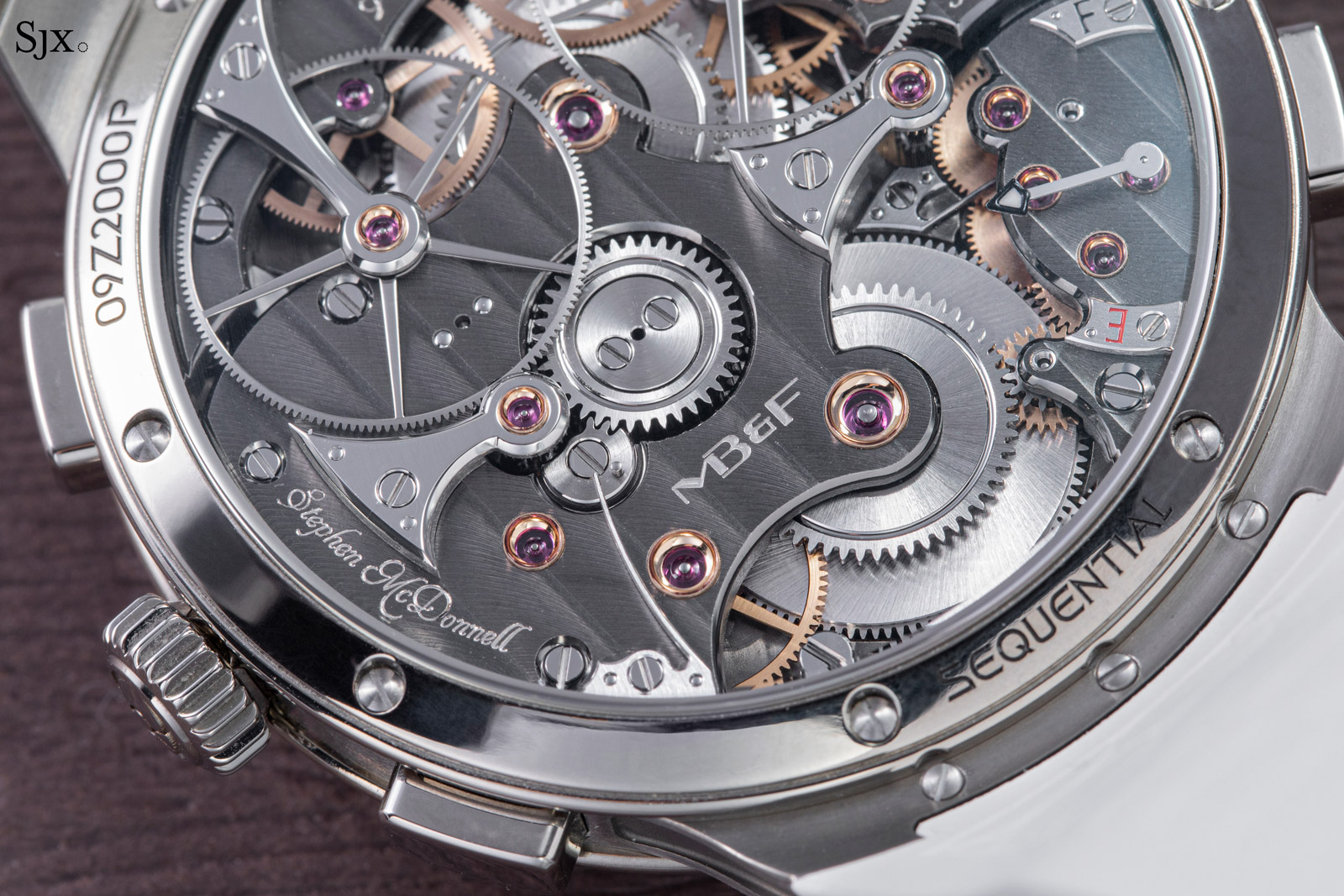
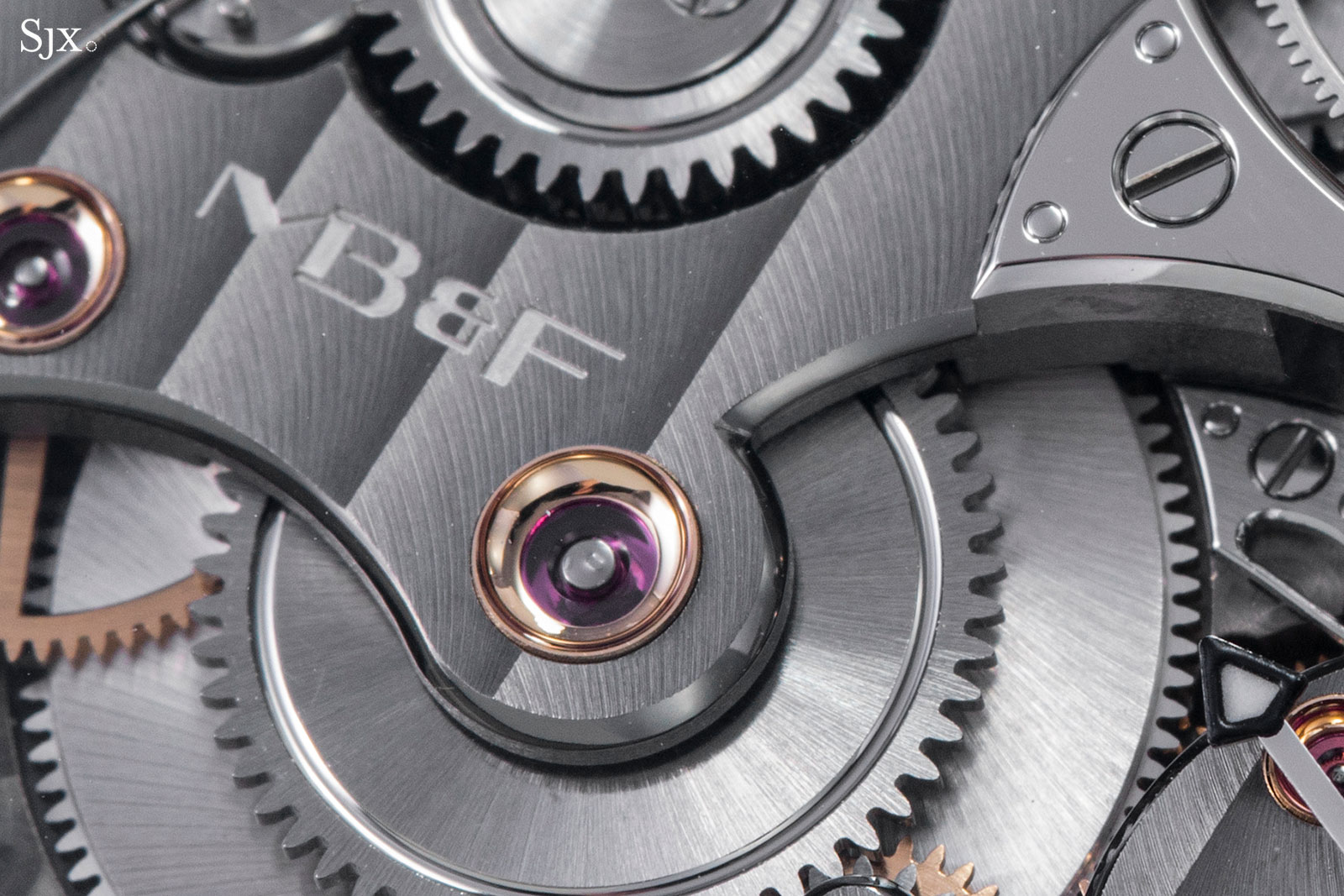
A pleasing detail not found on other LM movements is the quartet of steel cocks that support the fourth wheels and the large intermediate wheels for the minute counters. Elegantly designed to boast sharp inward and outward angles, the steel cocks are finished especially well, largely due to the black-polished top surfaces that instantly allow them to stand out against the striped bridges.
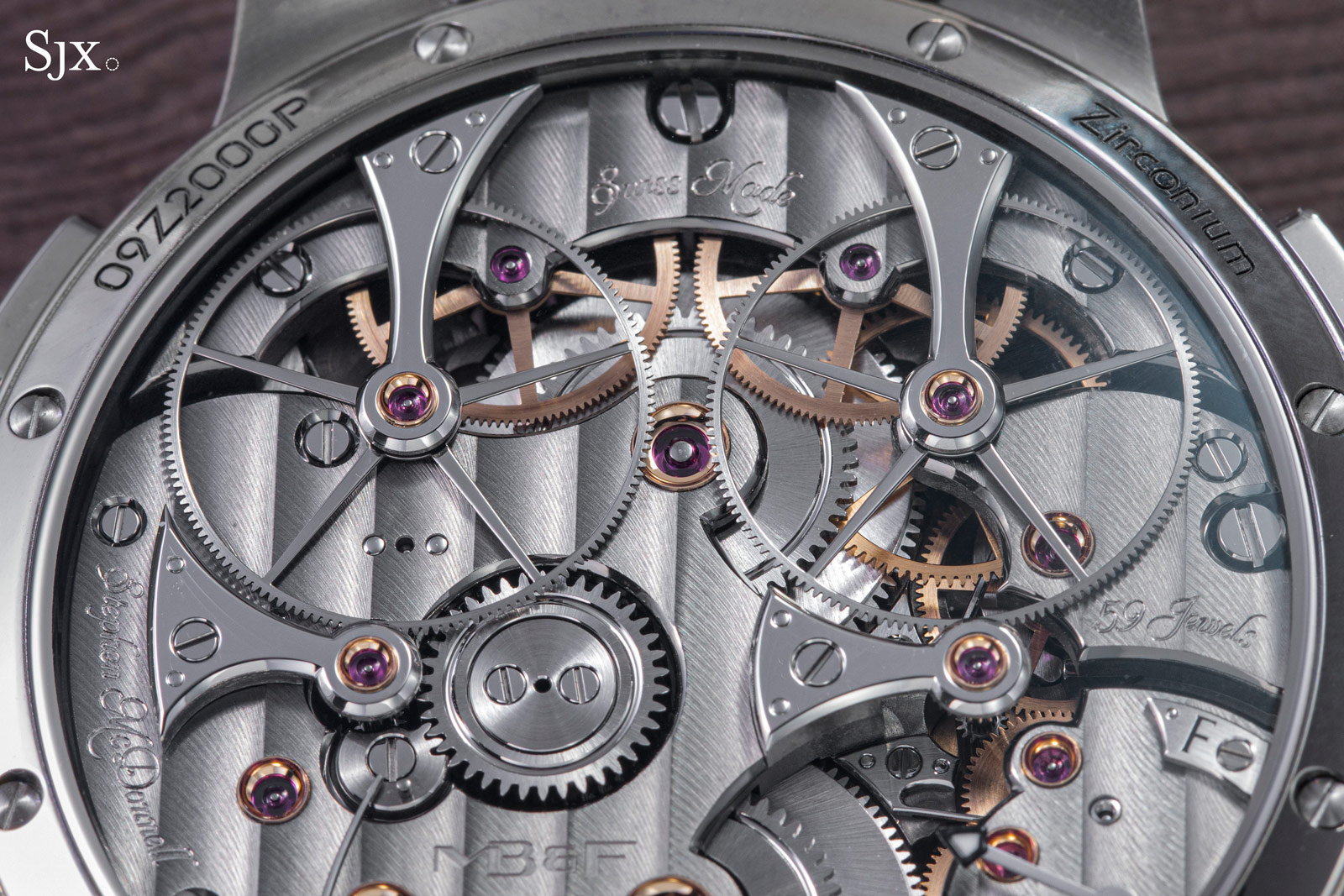
Notice the four distinct black-polished steel cocks, with two supporting the large intermediate wheels
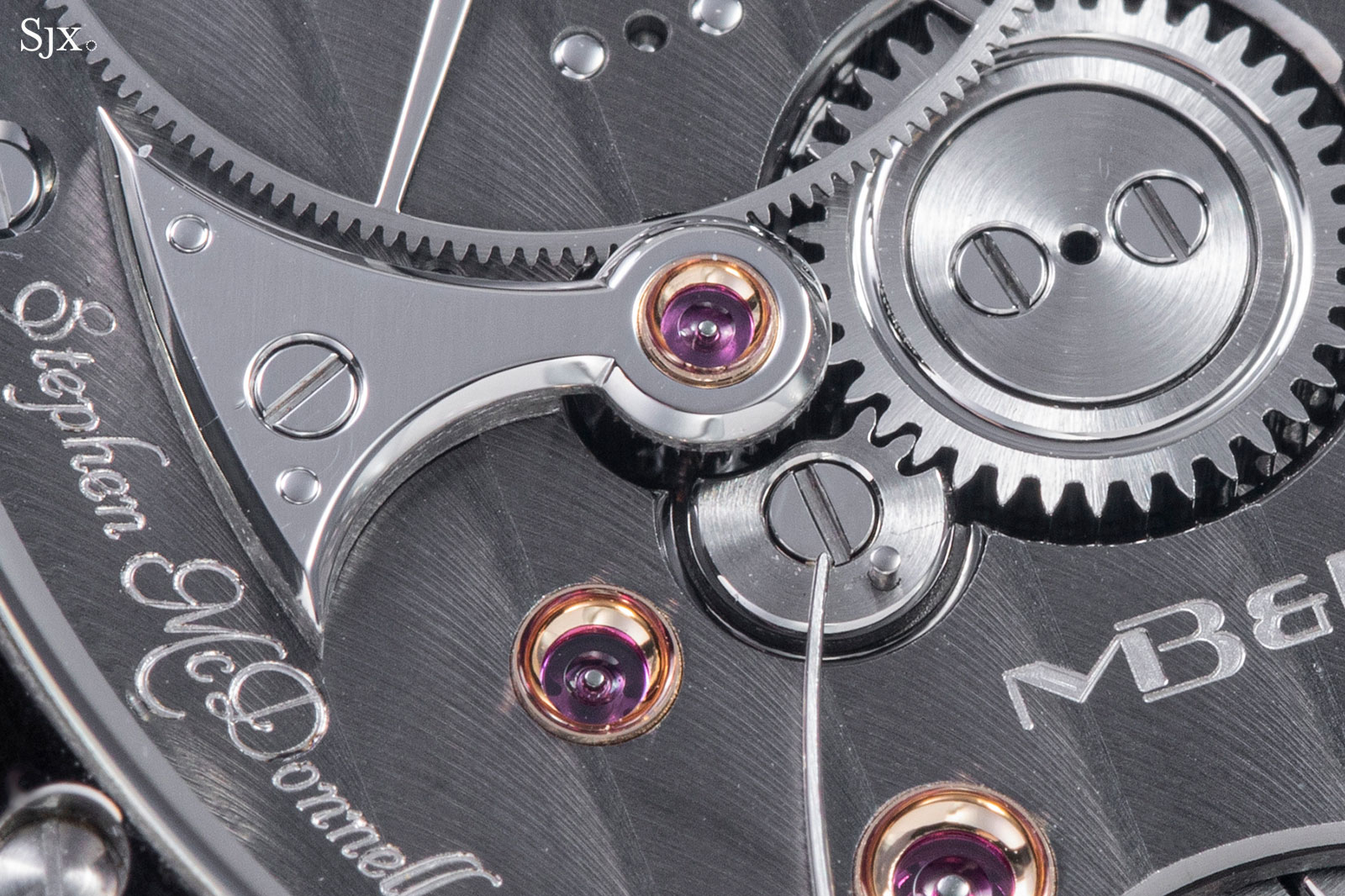
The steel cocks frame the large intermediate wheels, which are also finished in an outstanding manner. Instead of the concentric brushing that is convention, the narrow spokes of the wheels are polished, creating contrast with the brushed rims.
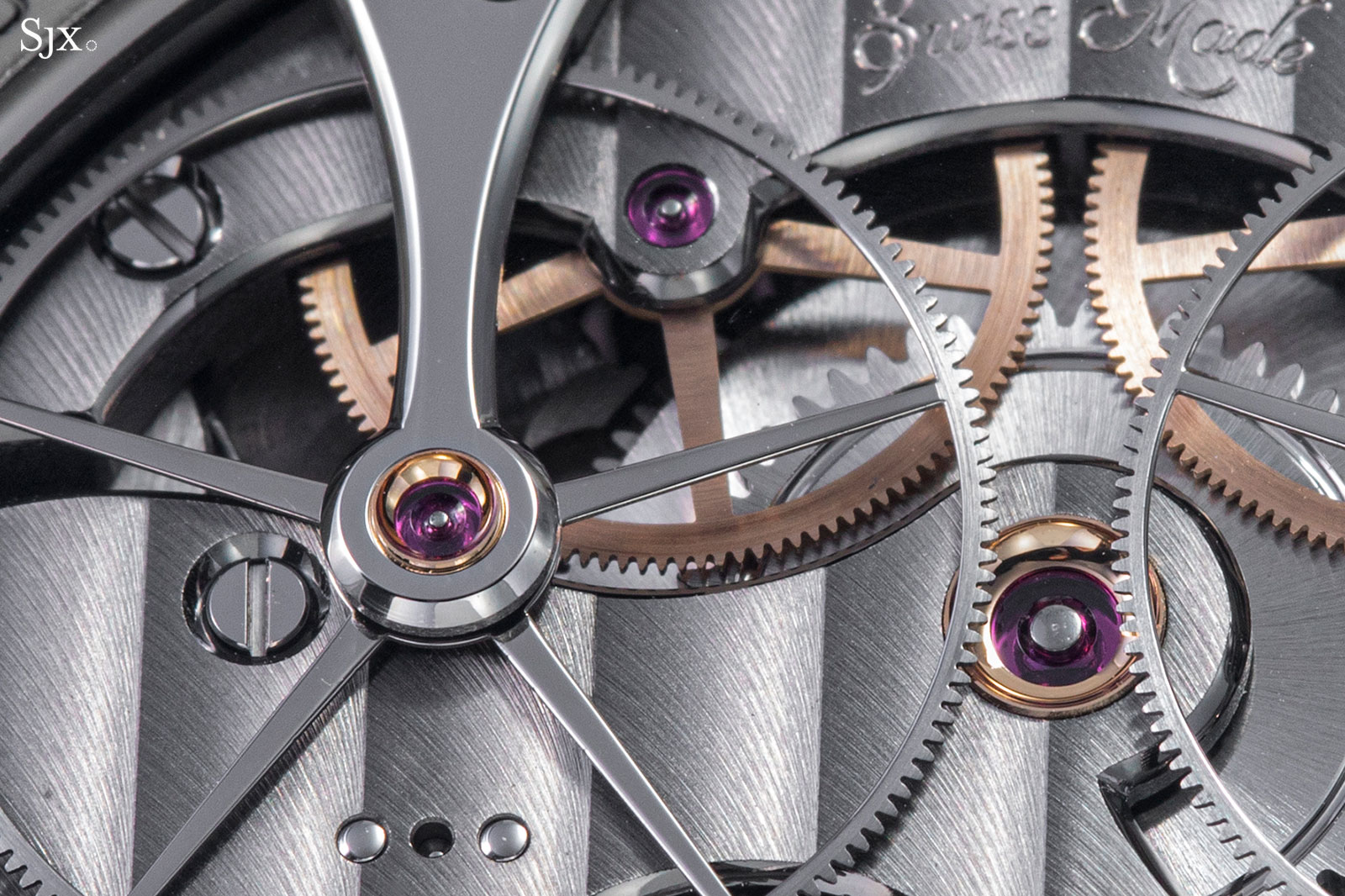
Despite their slimness, the spokes and rims of the intermediate wheels are decorated
Concluding thoughts
The Sequential EVO wants to be the Swiss Army knife of chronographs. It has impressive versatility in function – albeit with limitations in the hashmark-less seconds registers – accompanied by eye-catching visual complexity. While the premise of two chronographs in a single movement does not sound revolutionary, the execution is unquestionably excellent, with everything having been thoughtfully optimised to ensure efficient use of space while boasting visually intriguing mechanics.
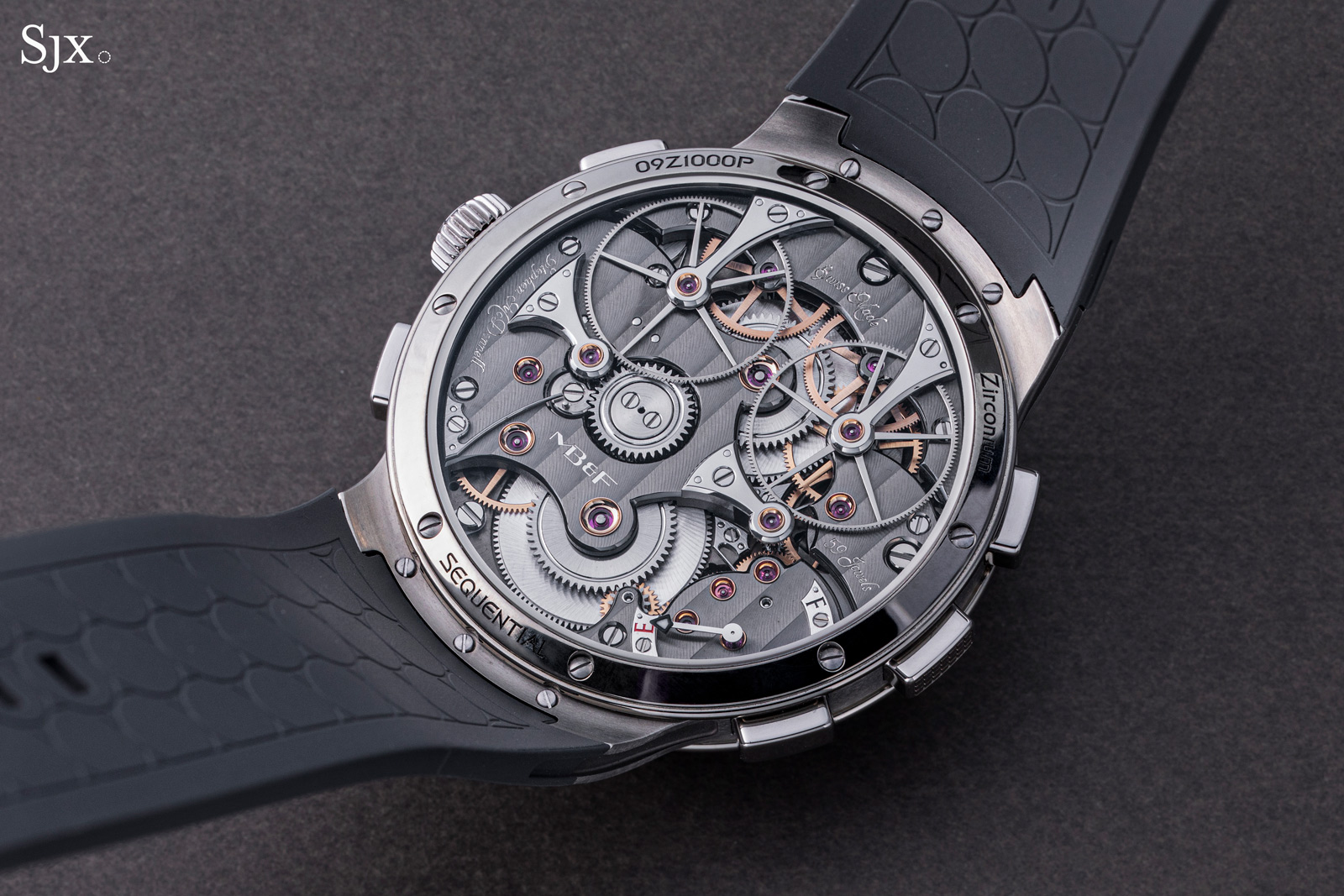
Key Facts and Price
MB&F Legacy Machine Sequential EVO
Diameter: 44 mm
Height: 18.2 mm
Material: Zirconium
Crystal: Sapphire
Water resistance: 80 m
Movement: Chronograph movement developed by Stephen McDonnell
Functions: Hours, minutes, power reserve indicator and twin chronograph function
Winding: Hand-wound
Frequency: 21,600 beats per hour (3 Hz)
Power reserve: 72 hours
Strap: Integrated rubber strap with titanium folding buckle
Limited edition: No
Availability: At MB&F retailers and MAD Galleries
Price: US$180,000 before taxes
For more, visit MBandF.com.
Amendment June 2, 2022: Fixed annotation of the dial gear train for the escape wheel’s location.
Amendment June 3, 2022: Added an explanation of a safety feature which prevents simultaneous activation of the Twinverter and chronograph pushers.
Amendment June 22, 2022: Revised several points after additional input and diagrams from Stephen McDonnell. Updated explanation of the design process of the twin going trains and jewelled vertical clutch.
Back to top.


